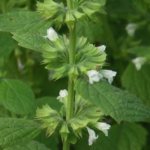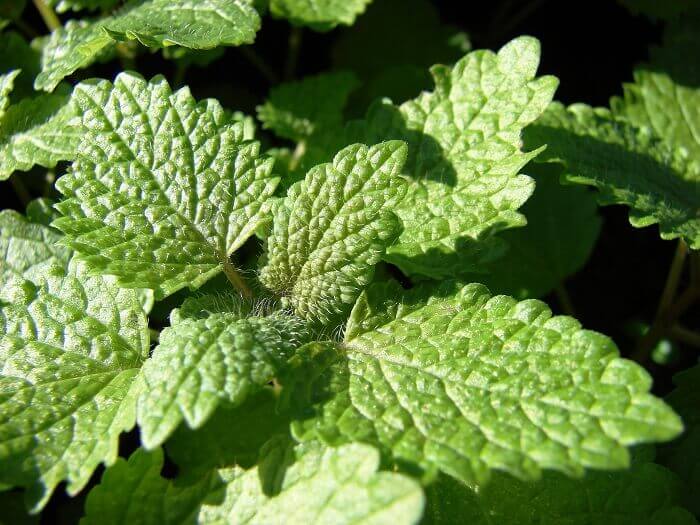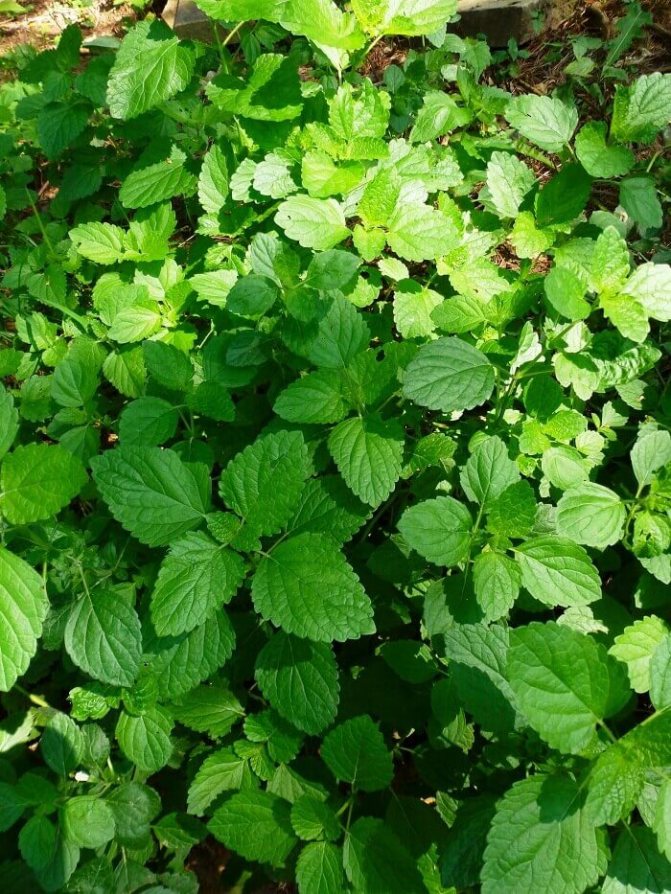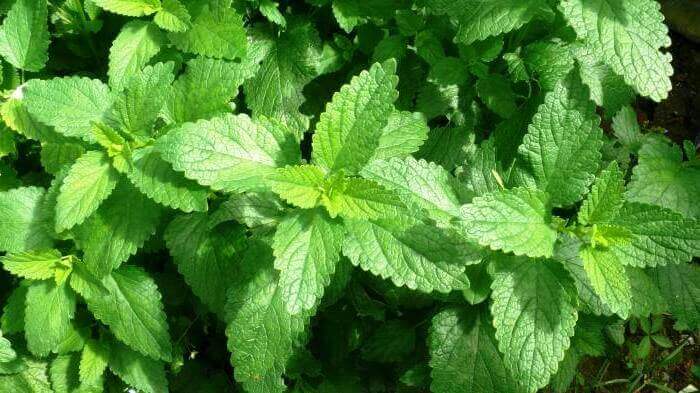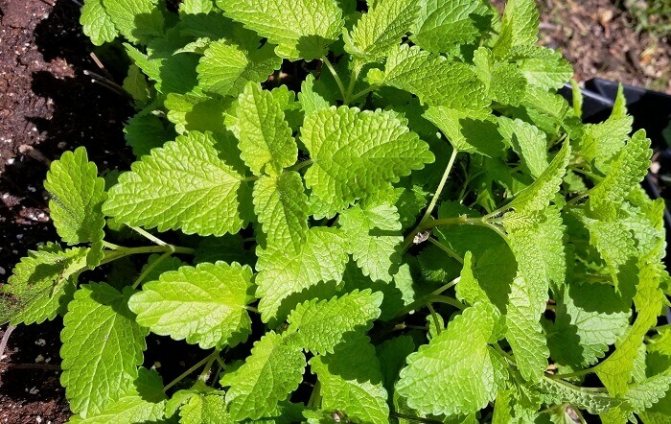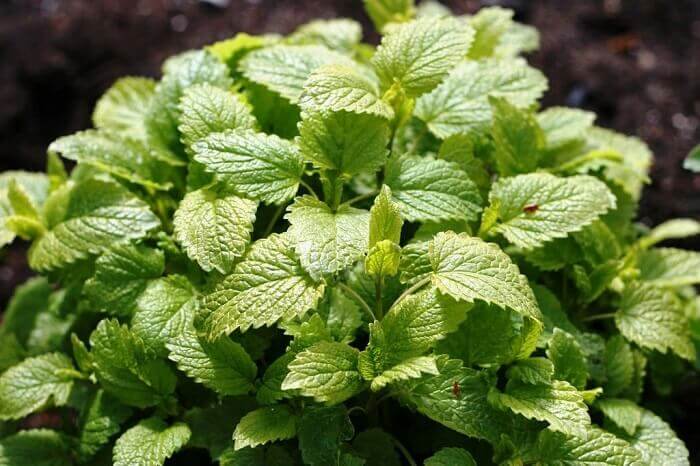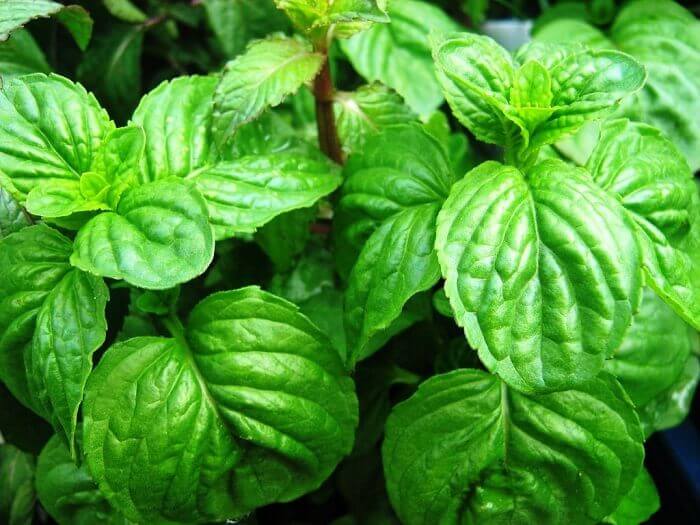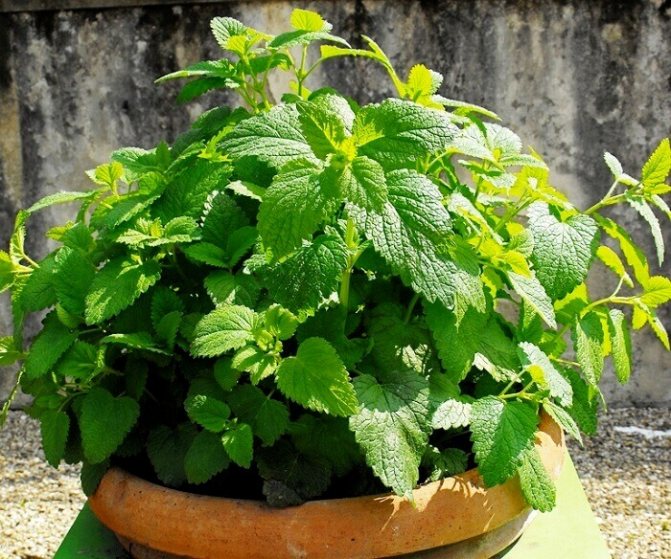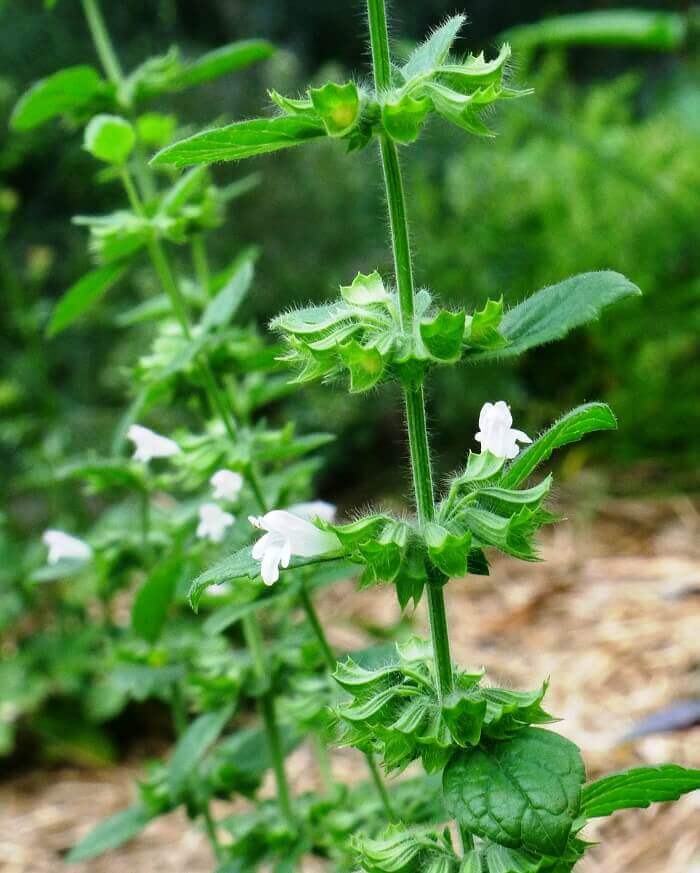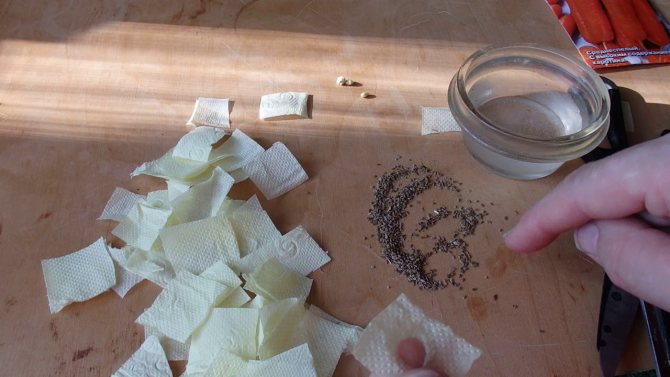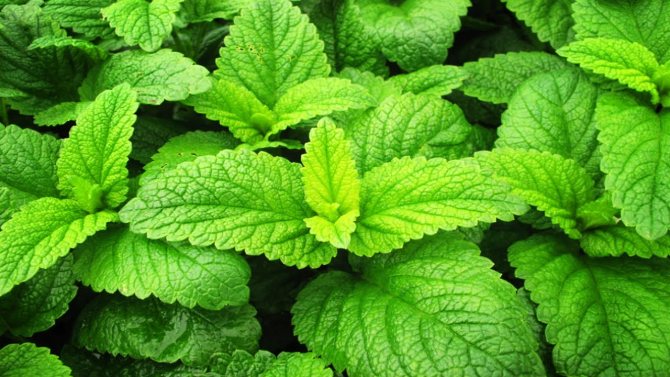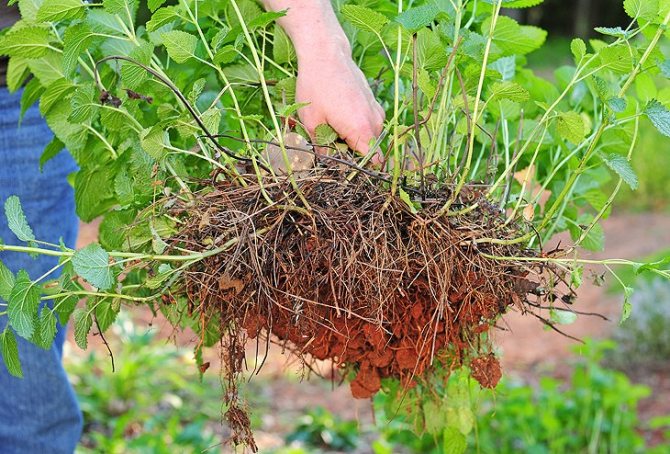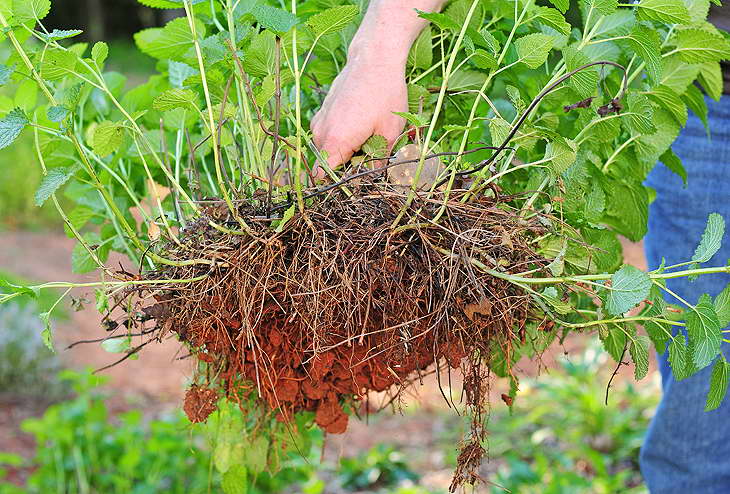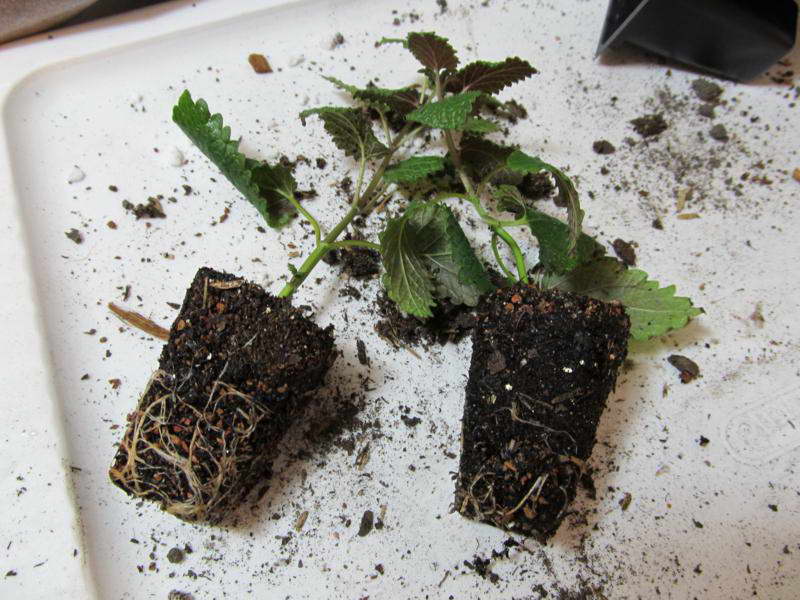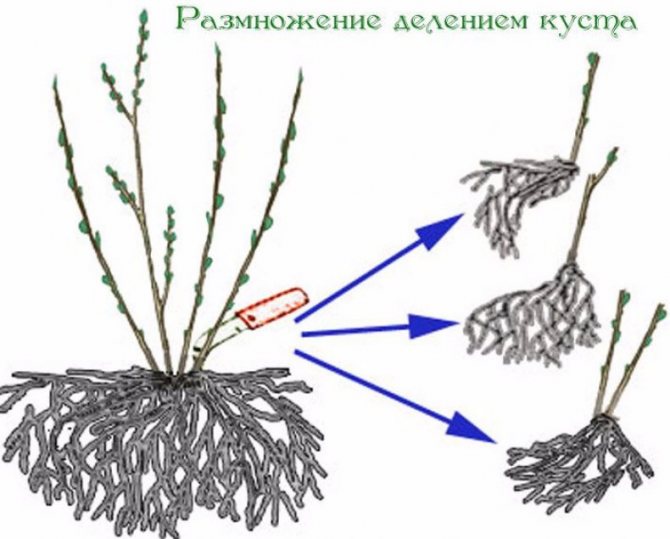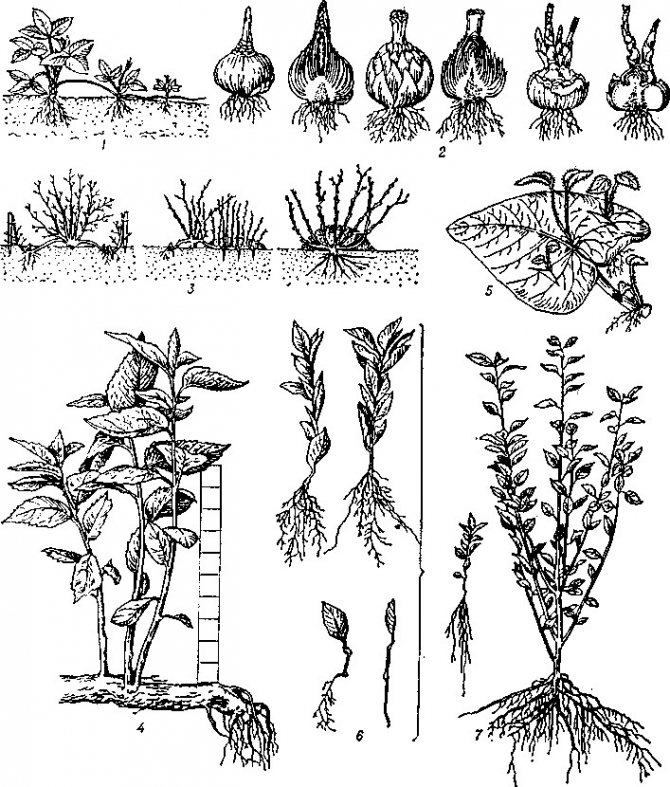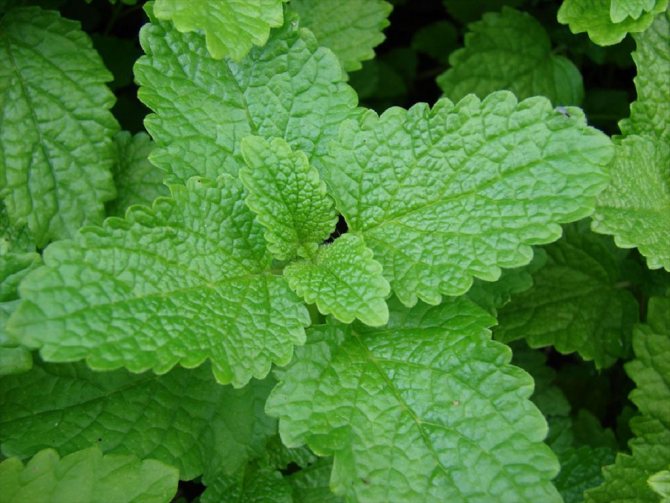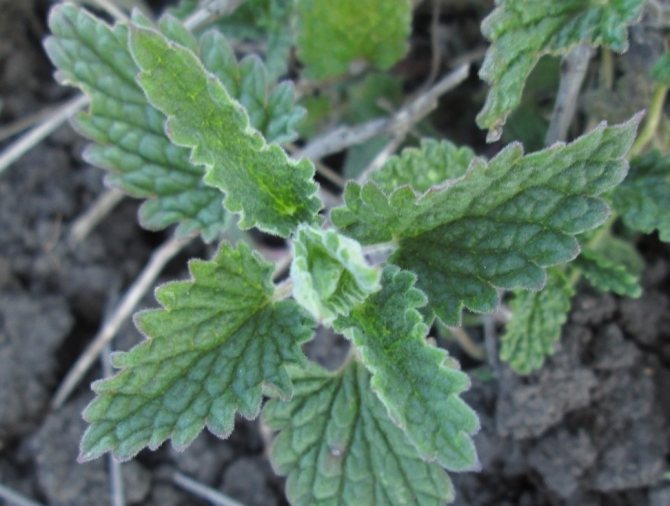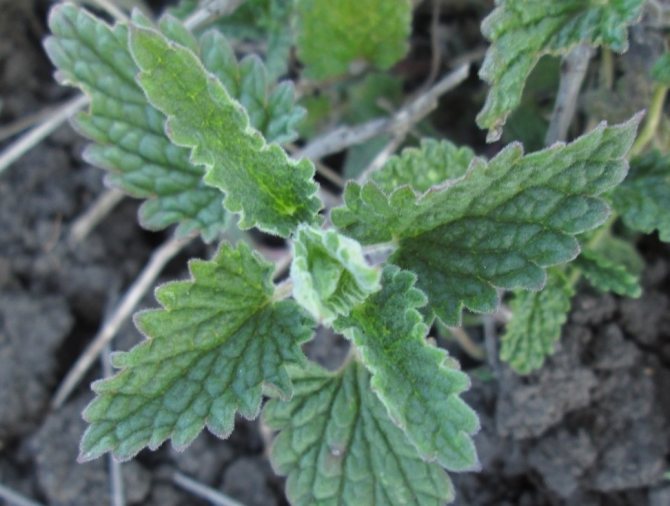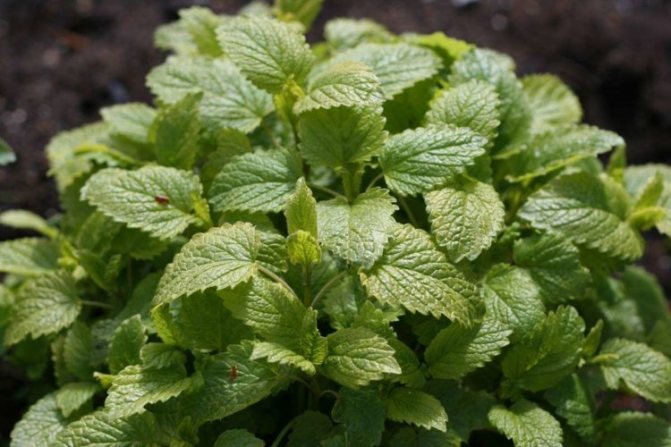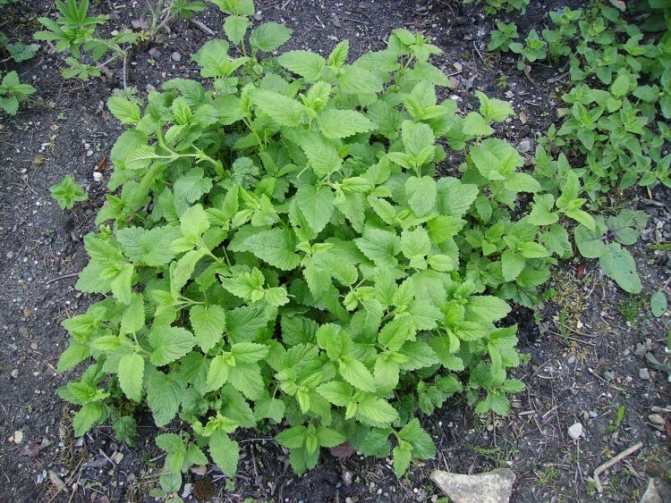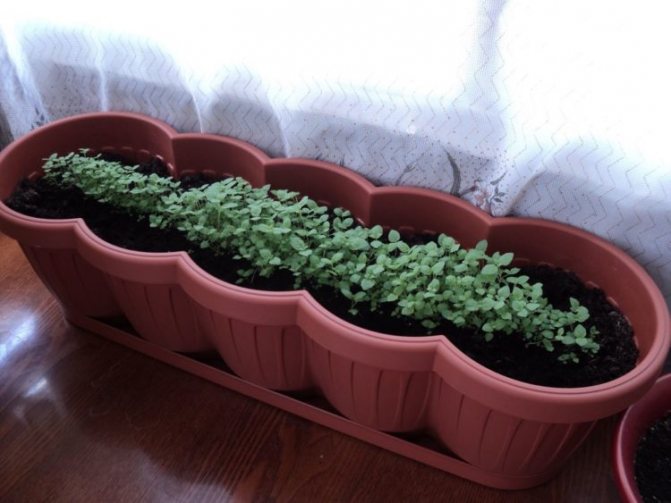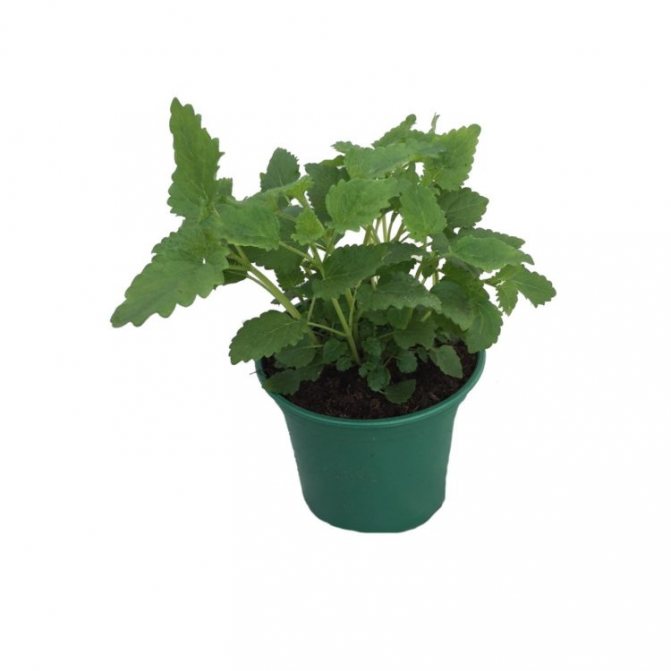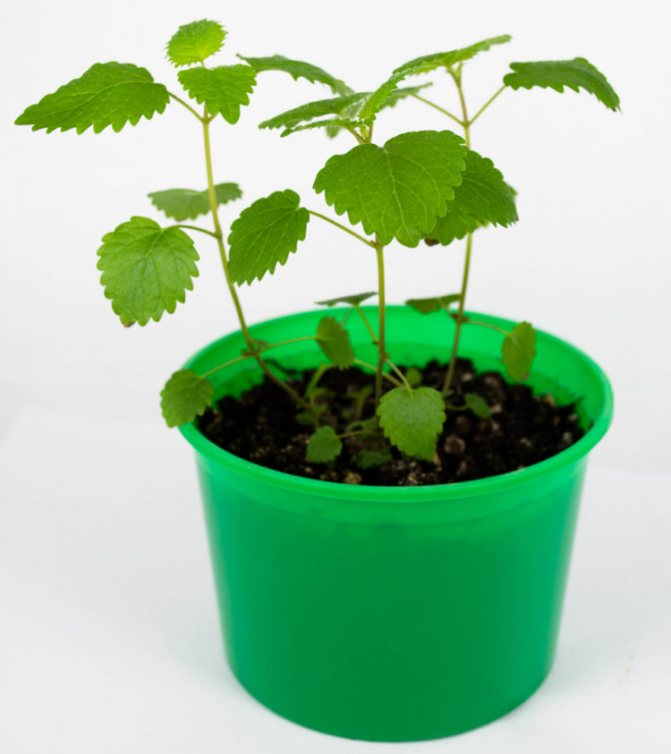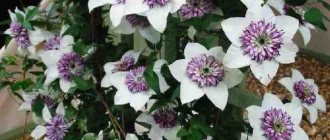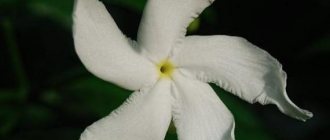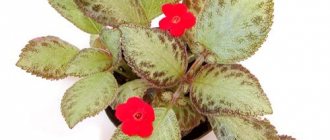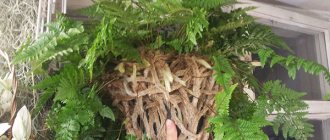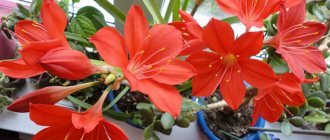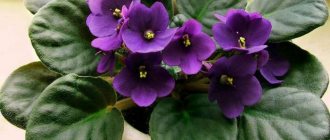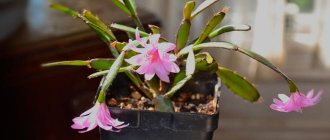Melissa, this plant can be seen in the photo, belongs to the Yasnotkov family. Perennial. Melissa is the herbaceous aromatic plant in the photo. As you can see in the photo, the plant looks like a nettle in appearance. Blooms from mid-summer. The flowers of this herb are on short pedicels. If there is an excellent snow cover, then lemon balm can easily survive the winter. But it is better to transplant in the fall using mulching, peat chips or dry leaves. For such an important process as planting lemon balm, it is better to select areas in the garden, where there is a lot of heat and sunlight. You can propagate using layers.
Lemon balm flowering
Mint grows to a height of about 110 centimeters. She has a tetrahedral, branched, erect stem. The leaves are opposite, ovate, with jagged edges, petiolate. The flowers, which have short pedicels, are located in the axils of the upper region of the leaves, they come in about 8 pieces. The corolla of the flower, as seen in the photo, has a pink color with red spots. Seedlings of this herb are brown or almost black, round in shape, the length of which is about 1.5 mm, and the thickness is about 0.8 mm, the weight of about 1 thousand seeds is about 0.55 g. The seeds germinate for about several years. Lemon balm can grow in one area for about 10 years. This plant is highly regarded as an excellent melliferous plant, moreover, it is used as a spice plant.
Culture type: spicy.
Growth: fast.
Lighting: bright.
Soil: light, loamy.
Growing method: by sowing in the ground, seedlings, layering and so on.
Features: grows in the same place for about 8 years. In the middle zone of the Russian Federation, it may freeze slightly in winter.
Seat selection
To begin with, you should choose a suitable place for lemon balm. Melissa is a rather unpretentious plant, it prefers loose, loamy or sandy loam soil, sufficiently fertilized. You should not "settle" bushes near a water source - lemon balm prefers drier places, and from the abundance of moisture it can get sick and die. If you plant lemon balm in the shade of trees, then, of course, it will survive, however, the smell from its leaves will be less intense. Less essential oil will accumulate in greens, and it is this oil that is the most valuable component of lemon balm. And the bushes will not grow so tall and lush. Partial shade is fine.
When choosing a place, be sure to keep in mind that lemon balm is a perennial plant. The bush can live up to ten years! In the fall, dig up the area intended for lemon balm to a depth of twenty centimeters, and fertilize with manure. In the spring, you can take a chance and plant seeds directly in the open ground, but this is a risky business. The seeds are planted no deeper than one and a half centimeters. If you plant lemon balm with seeds, then do not expect flowers from it in the first year.
Sun-loving lemon balm - where to plant it at home and in the country and how to ensure a comfortable stay?
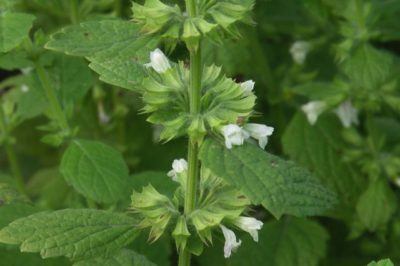
Melissa, which is popularly called lemon mint, mead, bee grass, has been widely popular since ancient times. The healing properties of lemon balm are used in folk medicine to treat diseases, it is part of many medicines.Especially often the plant is used for increased emotional excitability, irritability, sleep disturbance.
Leaves and young shoots of lemon balm are used in cooking as a spice - both fresh and dry. In addition, the plant is unpretentious and anyone can grow it. The main thing is to choose the right place for landing. Our article will tell you where it is better to plant a plant, what it loves more, shade or sun, and where the culture will develop better.
Planting seeds for seedlings
The most preferred method is to plant lemon balm with seedlings. To do this, around the end of March, sow the seeds in cups or a box and place it on the windowsill. If you are a happy owner of a greenhouse, then you can sow lemon balm seeds in a greenhouse. When planting seeds for seedlings, sow them not deep at all, about half a centimeter. Then the seedlings will be more friendly. Discharge the emerging plants so that there is space between them, otherwise they will interfere with each other. There should be gaps of about five centimeters between the shoots. Little melissa loves a lot of light. Keep the box with seedlings on the lightest windowsill, and on warm sunny days take it out for a walk on the balcony. It will not be superfluous to add some nitrogen fertilizers.
Top dressing of lemon balm
All the time of development and growth, lemon balm requires moderate feeding. For this, a special fertilizer is usually used, which is diluted according to the instructions. It is enough to use the root method, although young plants can be sprayed with a spray bottle - this will give them strength.
It is recommended to conduct feeding sessions once every two weeks.
The incomprehensible points that relate to the cultivation of this culture for seedlings, or in room conditions, will be explained by step-by-step instructions with a video:
Planting seedlings in open ground
Seedlings are planted in open ground at the age of one - one and a half months. Small bushes are afraid of frost, so plant them when the risk of frost is minimal. Bushes are planted at a distance of thirty centimeters from each other, and between the rows it is necessary to leave more space - sixty centimeters. Lemon balm care consists in loosening the soil and removing weeds. Watering should only be done if the summer is very dry. Melissa loves feeding, but do not feed the plant before flowering, as this prevents the seeds from ripening in time.
If you already have one lemon balm bush in your garden, but this is not enough for you, then you can propagate it without resorting to sowing seeds. Bend a few lemon balm twigs to the ground and sprinkle it with earth, they will take root, in the spring you can separate them from the main bush and plant. This procedure should be carried out in early summer. Do not forget to water the soil with which you sprinkled the twigs, otherwise they will not take root.
There is another way to propagate an old lemon balm bush - by dividing the bush. The procedure should be performed in early spring, when shoots are just emerging. The bush should be cut into approximately equal parts so that at least four shoots extend from each part. Only a bush that is at least three years old can be divided into parts.
So that the lemon balm overwinters well and the rhizome does not freeze, it can be covered with foliage fallen from the trees.
It got its name in honor of the ancient Greek nymph Melissa, the ancestor of beekeeping. Melissa is a godsend for gourmets who dream of combining a citrus scent with a pleasant mint flavor and some honey notes that faintly play through two such strong aromas.
Therefore, it is lemon balm that is suitable for many dishes where you want to feel the citrus flavor, but without the acidity inherent in many. Often referred to as "lemon mint" (not to be confused with the variety), Melissa is an excellent soothing and beneficial herb in the "heart" areas and is widely used as a food.It can emphasize and make elegant many dishes, for example, soup made from tasteless spinach will acquire a spicy, bright taste with lemon balm.
This plant belongs to the labiate family.
Medicinal, or lemon balm grows in the form of branched bushes from 45 to 125 cm in height. Flowers can be white, pink and yellow. Essential oils are mostly found in the tops of the shoots and in the leaves. This plant is a good honey plant, in this regard, beekeepers and many gardeners call lemon balm "bee mint". She belongs to, therefore, she will delight for more than one year.
For lemon balm, you should choose a sunny or slightly shaded place with fertile, well-drained loose soil (sandy loam, for example). The reaction of the soil can be neutral or slightly acidic.
For perennials, I usually prepare the ground in the fall. I dig it well, free it from weeds, add organic and mineral. I have no problem with water outflow on the site, but if your soil is acidic, consider drainage. It can be small rubble or broken brick. The main thing is that there is no root decay. I have slightly acidic soil in a place where herbs grow, this is evidenced by the presence. I add woody to the soil. My soil is loose and light enough. But if your soil is clayey or low, then dilute the soil with river sand and make high beds when planting lemon balm.
In the spring, when the soil warms up, you need to loosen the prepared area, and also remove it. I marked out small ridges, between rows about 45 cm, planted in 2 rows. Between the plants I took about 40 cm, I was not mistaken, since the bushes have grown very much. If I planted this plant again today, I would take the distance between the rows and between the plants more, about 60 cm each, for a more aesthetic look.
Melissa reproduces by dividing the bush and seeds. My delenki take root immediately and give good flowering. It is worth dividing the bushes when the shoots begin to grow, this is somewhere in the beginning of May, or you can divide the plant at the end of August. Seeds sprout weaker. They are small and require light for germination. Embed them in the soil no deeper than 1 cm.
You can sow lemon balm immediately into the ground at the end of May
, or you can plant seedlings somewhere in late March - early April. In May, ready-made seedlings with 4 normal leaves are planted in the ground (the seedlings are about 40 days old). Many amateurs dig out part of the lemon balm bush for the winter and grow it at home on the windowsill. You can also grow a potted plant from seeds, but lemon balm loves freedom, so it grows poorly in a pot.
Growing
Consider growing lemon balm using seedlings. Melissa has rather small seeds in the photo, which can remain viable for several years. In the spring, lemon balm can be planted in open ground, while seedlings should be sprinkled no deeper than 1.5 centimeters, however, this is a risky business. If, nevertheless, you can grow lemon balm in the garden with the help of seeds, then during the first year you do not need to wait for flowering from it, as in the photo below.
The most preferred method is to plant lemon balm in the garden using seedlings. For this process, in the last days of March, you need to plant the seedlings in a glass or boxes and put them on a well-lit windowsill. Please note that lemon balm seeds have a low germination rate. If you have a greenhouse, you can sow grass seeds for seedlings in greenhouses.
When planting mint seeds as seedlings, you need to bury them not very deeply. Then you will get more friendly shoots. It is necessary to discharge the mint that has appeared so that there is a place for growth between them, otherwise they will interfere with each other to develop well. Leave a distance of about 5 centimeters between the plants.
Small seedlings need good lighting.You need to keep a container with seedlings on the lightest side of the windowsill, and on warm days you need to take them out to the balcony. It also does not hurt, as shown in the photo, to add a little nitrogen fertilizer to the soil for excellent seedling development.
Lemon balm varieties
Consider a vegetative breeding method for lemon balm. If you have a mint bush in the photo in your garden, however, this is not enough, then you can propagate the plant vegetatively, without resorting to sowing seeds. You need to bend a couple of branches of the lemon balm plant to the ground, then you need to pin and sprinkle with soil - they will start to take root. A similar procedure must be carried out in the first days of the summer period. It is also necessary to water the soil around the planting all the time, so the sprinkled branches can take root better. Therefore, watering must be timely. And in the spring, it is necessary to separate them from the mother bushes and plant them on a permanent site in the garden.
Melissa, which has reached the age of about 3 years, can already be propagated by dividing the bushes. It is better to carry out this process in early spring, when young shoots have only recently appeared in mint, or in late August. It is necessary to cut the mother bush into parts of almost the same size so that any division has at least 4 shoots with a root system.
Lemon balm varieties
In total, today about 5 species of such a herb as lemon balm are known, however, lemon balm grows in Russia. Melissa officinalis has an unusual variety - variegated. Its extraordinary leaves contain a huge amount of phytoncides that can purify the air, and also look great in a flower garden. Melissa is so fond of among gardeners, as it creates a dense bush, can take root even in partial shade, besides, the bushes have an even, beautiful shape, although the smell is not very pleasant.
The State Register of Russia consists of 8 types of lemon balm, which are adapted to our climatic conditions. They can be planted in garden plots. The new varieties of lemon balm, which have an unusual golden color of leaves, have the same beautiful color. Due to the different leaf shapes and types of flowering, one plant variety can be distinguished from another.
Consider the most common varieties today:
- Lemon flavor
This variety can be used both fresh and dried. Perennial, in one area can grow for about 5 years. Starting from the second year of growth, 40 days usually pass from germination to the very first cut. The leaves are dark green in color, they have a bloom on the surface, they are slightly raised. The leaves are ovoid. Smooth-type leaves are slightly descent. In growth, this variety reaches about 58 centimeters. The green weight of the bush during the first year of life is about 100 g. This variety has a very strong aroma.
This variety has a mid-early ripening period, it is a perennial plant that has been growing in the same area for more than 4 years. During the second year of life, the growing season reaches approximately 1.5 months. In growth, the bush reaches about 80 centimeters. Leaflets are half-raised. They have a dark green color around the edges with denticles. The flowers are rather small with a white color. This mint variety has a pronounced lemon aroma, but not as strong as the previous variety.
- Pure gold
This species has golden leaves. A compact bush. The flowers initially acquire a white color, by the middle of the flowering period they melt a slightly purple hue.
Care
Peppermint is a cold-resistant crop. It is capable of wintering in open soil, however, in central Russia in some years frost was encountered, so it is better to mulch the grass before the winter cold with peat. Seedlings germinate at a temperature of about 11 degrees.The best temperature for growth is around 23 degrees. The plant loves well-lit areas, which are also well protected from the cold wind from the north. You need to plant grass in slightly loamy soil, which has a neutral environment. Grass does not like acidic soil. The best solution is to land in an elevated position. The territory must be selected outside the crop rotation, since lemon balm has been growing in the same place for about eight years.
Melissa care
You can grow lemon balm:
- sowing into the soil;
- seedlings are the most common method;
- stem layering;
- green handle;
- dividing the bush into parts is the most convenient way for the garden.
Planting seeds or seedlings of lemon balm should generally be much earlier than the grass was able to take root perfectly. An excellent effect can be obtained by propagating green cuttings. Sowing should be mulched with peat or compost. Planting grass can survive during the formation of several leaves on the stem, while leaving the plant about 28 centimeters between them. During the second and subsequent years of the growing season, the grass must be fed twice a year with the help of mineral fertilizers. The first feeding should be done in the spring, in the first days of the growing season.
Lemon balm is a perennial herb of the family Labiatae. Lemon balm comes from Southern Europe. Cultivated in various countries of Europe, Asia and North America. The plant is ancient. Feral forms are found in the Crimea, the Caucasus and Central Asia. Melissa is a spicy flavoring plant. Rich in vitamin C and carotene. An essential oil containing citral and citronellal (up to 60 percent), geraniol and myrcene is extracted from fresh herbs. The leaves have a lemon, bitter aroma, slightly spicy taste.
Leaves and young shoots are used fresh or dry as a seasoning for salads, soups, fish, mushrooms, compotes, drinks, for flavoring vinegar, tea, liqueurs. It is used for medicinal purposes with general weakness of the body, gastric diseases, neuroses of the heart, as an easily aphrodisiac. Used in perfumery.
Botanical characteristics of lemon balm.
The stem is straight, branched, pubescent, up to 125 centimeters high, the lower lateral shoots are creeping. The leaves are petiolate, ovate, their edges are serrated. Inflorescences of three to five sit in the axils of the upper leaves, tilted to one side. The flowers are bisexual, light purple, white, yellowish or pink with a red spot. Blooms in the second year after sowing from July to August. Good honey plant.
Biological characteristics of lemon balm.
Melissa is demanding for warmth and light. Seeds begin to germinate at 10 ... 12 degrees. The optimum temperature for germination is 20 ... 25 degrees. Lemon balm is sensitive to frost and often freezes out in open places, therefore, it is placed in areas well-lit by the sun and protected from the winds. In the Non-Black Earth Zone, it gives abundant greenery. The seeds ripen. Melissa does not tolerate acidic, moist, heavy, structureless soils at all. For her, you need to choose moderately moist structural light and fertile soils.
Lemon balm agrotechnics.
The best predecessors in crop rotation are vegetables, potatoes and perennial grasses.
In autumn, the soil is cultivated to a depth of 4 ... 5 centimeters. After 15 ... 20 days, after the germination of weeds, it is plowed or dug up to 25 ... 30 centimeters with the simultaneous introduction of manure 3 ... 4 kilograms per square meter. In the spring, before planting, one or two loosening (harrowing) is carried out, under which up to 30 ... 40 grams of complex fertilizer per square meter are applied. If the soil is acidic, fluff lime or dolomite lime is used.
Melissa is propagated by seeds - seedlings, as well as dividing the bush, layering and cuttings.
Seeds for growing seedlings are sown in greenhouses in March - April. For more even sowing, wet sand is mixed into them.Seedlings appear in three to four weeks. Seedlings are planted in early spring with a row spacing of 40 centimeters, plants in a row - 30 centimeters.
For reproduction by dividing the bush, take three, five-year-old plants. Planting is carried out in early spring or August. It is enough to grow 10 ... 12 plants on personal and garden plots. If there are hives, then the planting should be expanded, since lemon balm is a strong honey plant.
Melissa is picky about loosening the soil. Crusting has a negative effect on the yield. It is carried out as often as possible, weeding - 2 ... 3 times per season.
In spring, plants are fed at the rate of 30 ... 40 grams of complex fertilizer per square meter. Since lemon balm is very responsive to nitrogen fertilizers, a solution of slurry (1: 6) or poultry manure (1:10) can be used for feeding at the rate of 10 liters per square meter. After each harvest, feeding is repeated.
For better wintering, the plants are covered with earth in the fall, and open in early May. Small areas can be covered with manure or foliage.
Harvesting lemon balm.
They start harvesting before flowering or during the opening of flowers. Shoots are cut and dried immediately in the shade. For mass harvests, it is better to use artificial drying at a temperature of 25 ... 35 degrees. In the first year, up to 500 ... 800 grams per square meter of fresh leaves are harvested, in the second - up to 1 ... 1.8 kilograms. Sometimes, especially in the south, cleaning is carried out 2 ... 3 times per season.
For seeds, lemon balm is harvested when the lower seed pods are browned. Plants are cut or uprooted, tied into sheaves, transferred to a well-ventilated room for ripening and drying, then threshed, the seeds are cleaned. They are small, retain their germination well for two to three years.
Diseases of lemon balm.
It is affected by mint rust and septoria, especially in wet weather and with neglected plantings. It is necessary to thin out seedlings in a timely manner, clear the area of weeds, remove and burn dried plants.
In our previous article, we talked about the cultivation and use of peppermint - one of the most popular spicy aromatic crops in our area. Today we propose to talk about no less popular, and certainly no less fragrant and beloved plant - lemon balm. You will now find out how lemon balm is grown, lemon balm propagation, planting and care, and what, in fact, is the use of lemon balm.
Collection and preparation of lemon balm
It is worth collecting lemon balm foliage before flowering
, although many gourmets harvest it during the flowering period. It is best to start picking in June, the young leaves have a delicate aroma and taste.
When the lemon balm has blossomed, its aroma and taste intensify and become more harsh. Lemon balm leaves have essential oils, so they should be in the shade, but not more than +35 ° C. After drying, carefully fold the raw materials into sealed containers. Melissa does not go into freezing, because it loses its useful properties.
1 Melissa - home care
1.1 Temperature conditions
During the growing season, it tolerates a wide range of temperature conditions, and in the winter months it needs a cool dormant period at a temperature of 5 - 7 ° C, but not higher than 10 ° C.
1.2 Reproduction of lemon balm
Melissa is usually propagated by dividing large mature plants when transplanted or by half-mature stem cuttings. Cuttings can be rooted even in plain water. It is also not difficult to grow lemon balm from seeds that are sown on the surface of the soil, without covering it with earth.
Up in the menu
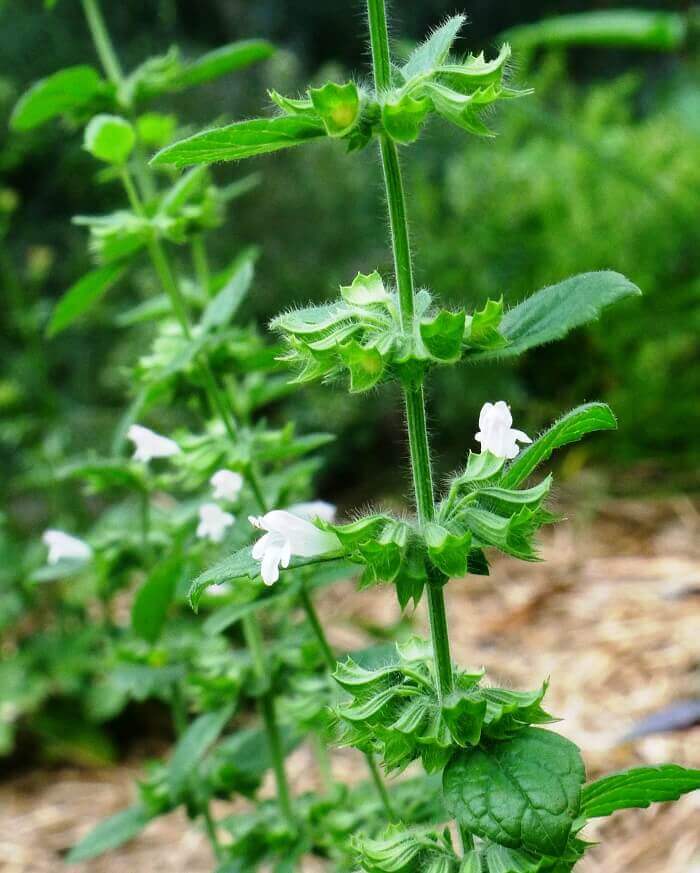

1.3 Lighting
Melissa indoor does not like direct sunlight and is preferable for her cultivation in partial shade.
Up in the menu
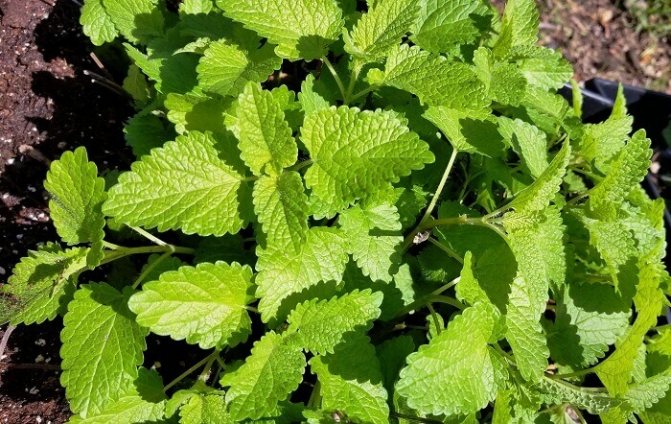

1.4 Growing lemon balm
Unpretentious and very useful plant. Melissa needs to be pruned 2 - 3 times during the growing season to give a beautiful compact shape, it is easy to prune.Flowers in indoor plants are usually removed so that seeds do not form, which germinate when they fall into the ground.
Up in the menu
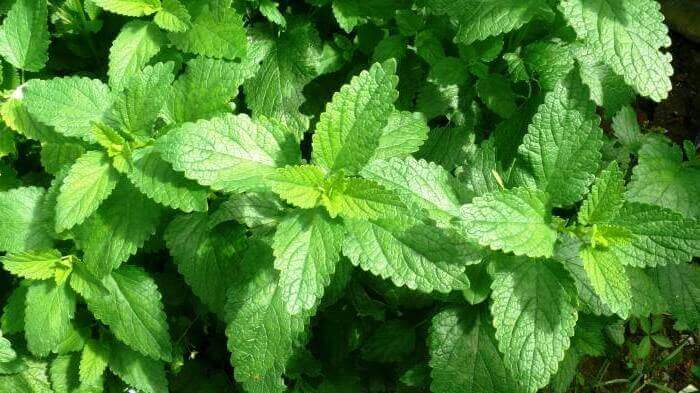

1.5 Soil
The plant thrives in any soil, tolerates even nutrient-poor substrates with good drainage.
1.6 Transplanting lemon balm
Transplanted annually, in a larger pot, in the spring.
Up in the menu
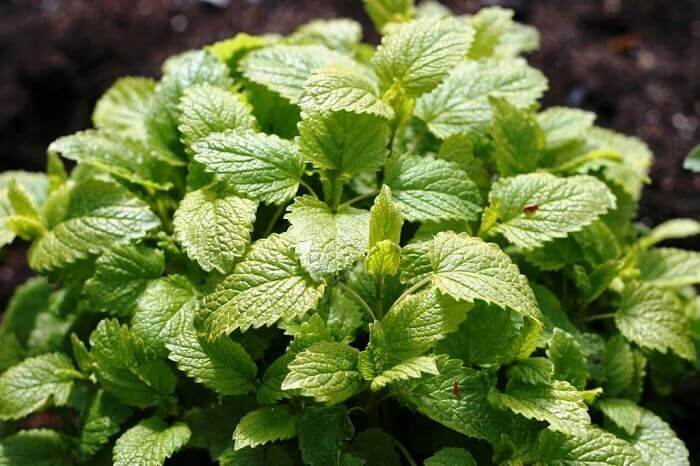

1.7 Top dressing
Feed with water-soluble fertilizers monthly during the growing season.
1.8 Purpose
Lemon balm leaves have a very pleasant aroma and are used to prepare all kinds of dishes, as well as for refreshing drinks, it is better to collect them before flowering.
1.9. Lemon balm flowering time
From June to August, however, flowering is of little interest.
Up in the menu
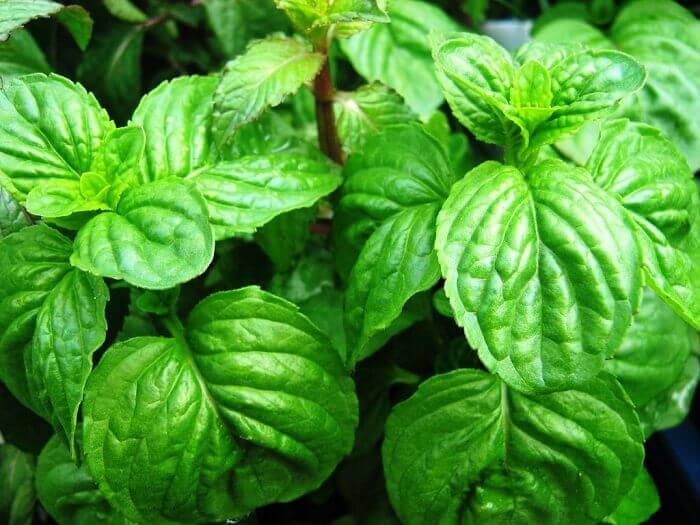

1.10 Air humidity
In spring and summer, if the indoor air gets too dry, you can increase the humidity with a room humidifier or by placing the plant on a pallet with damp pebbles. It is undesirable to spray.
1.11 Watering
Watering should be abundant during the growing season, it is better to use bottom watering, immersing the pot with the plant in a large container of water for a few minutes and allowing excess moisture to drain. In the winter period of rest, the soil is simply protected from complete drying out.
Up in the menu
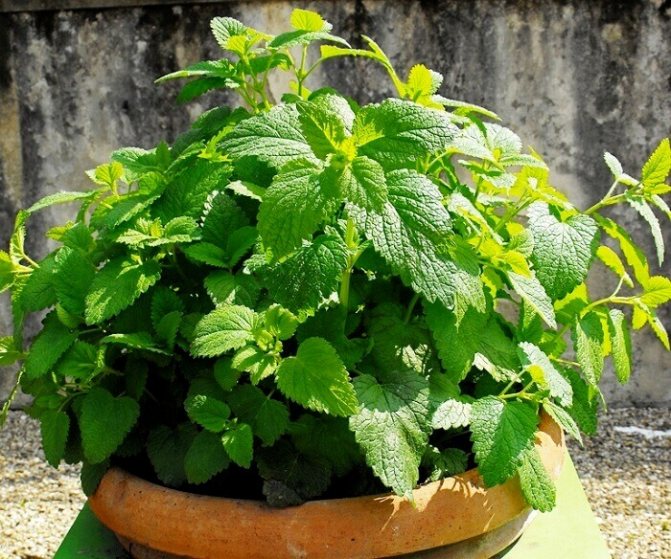

Lemon balm varieties
In total, there are 5 types of lemon balm in the world, but only lemon balm
... Lemon balm has an unusual variety -. Its original leaves not only contain many phytoncides that purify the air, but also look great in flower beds.
I like Melissa in planting due to the fact that her bushes are dense, they live in my penumbra, while the bushes themselves are even and beautifully shaped. However, I am indifferent to the smell.
The State Register of the Russian Federation includes 8 varieties of lemon balm
adapted to the conditions of the middle lane, recommended for planting in the garden area. They are not inferior to new varieties with an unusual golden color of foliage. The different leaf shape, color, height of the bush, winter hardiness and intensity of aroma and flowering time distinguish some varieties from others.
Melissa "Lemon flavor"
Designed for fresh and dried use. Perennial, growing in one place for about 5 years.
Melissa Lemon Flavor. Photo from the site
From the second year of life, about 40 days will pass from germination to the first cut. Leaves are dark green with a bloom, raised. The leaf is ovoid. Smooth leaves, pubescence. The height of the plant is about 60 cm. The green mass of the bush of this variety in the first year of life is about 120 g. The aroma is strong.
Melisa has a delicate, unobtrusive, pleasant aroma. She, like mint, has been popular with gardeners all over the world for many centuries. Already from the very name of the plant, one can judge its magnificence, because melissa was named after the exquisite ancient Greek nymph - Melissa. Melissa is a wonderful herb, which is a real boon for a culinary specialist. Due to its aroma, the plant is used to prepare various dishes. In lemon balm, honey and mint aromas are intertwined with a thin thread, ideally complementing salads, compotes, desserts. You can grow lemon balm on your own plot and even in pots on the windowsill. According to professional summer residents, there is nothing easier than growing lemon balm at home.
How to use lemon balm
The range of uses for lemon grass or lemon balm is quite wide. This is due to its composition. Lemon balm leaves contain essential oils, organic acids. They are rich in vitamin "C", various microelements: zinc, copper, potassium, manganese, molybdenum, selenium.
This unpretentious herb has found wide application in medicine. It provides relief from a number of serious medical conditions:
- Saves from irritability and nervousness, restores sleep.
- Recommended for heart disease and vascular spasms.
- Treats cancer.
- Relieves headaches by improving blood circulation to the brain.
- Helps to normalize blood pressure.
- Helps to cope with colds: relieves sore throat, relieves cough.
- It is prescribed to improve digestion for people suffering from gastritis, pancreatitis, cholecystitis.
- Eliminates increased gas production, constipation, malfunctioning of the pancreas.
- It removes toxins from the body, having a diuretic and diaphoretic effect.
- Reduces toothache, disinfects the oral cavity, relieving inflammation.
- It is part of the dietary food that helps to lose weight.
Melissa is an irreplaceable remedy for maintaining the health of the female body. It relieves pain during menstruation, helps to cope with toxicosis during pregnancy, and stimulates milk production during breastfeeding.
Cook remedies
from lemon balm is not difficult at all.
Can be done infusion
from the green shoots of the plant. To do this, pour the chopped lemon balm leaves (20 grams) with boiling water (1 liter), seal tightly and infuse for twenty minutes.
To prepare decoction
from this medicinal herb, boil two tablespoons in one liter of water for 15-20 minutes. Then remove from heat and let it brew for half an hour. Such a decoction is advised to drink four times a day, especially for patients with asthma and anemia.
Some people add lemon balm leaves to regular tea, mixing the drink with a little honey. It turns out to be an excellent prophylactic agent against viruses and colds.
If there are no lemon balm leaves at hand, you can successfully use the ready-made essential oil
plants. A few drops in a bathtub or scented lamp will help you calm down and sound asleep.
Growing lemon balm in your summer cottage or on your windowsill, preparing a dried product, you provide yourself with a healthy drink that can be consumed all year round, strengthening health, prolonging youth and preserving beauty.
Melisa has a delicate, unobtrusive, pleasant aroma. She, like mint, has been popular with gardeners all over the world for many centuries. Already from the very name of the plant, one can judge its magnificence, because melissa was named after the exquisite ancient Greek nymph - Melissa. Melissa is a wonderful herb, which is a real boon for a culinary specialist. Due to its aroma, the plant is used to prepare various dishes. In lemon balm, honey and mint aromas are intertwined with a thin thread, ideally complementing salads, compotes, desserts. You can grow lemon balm on your own plot and even in pots on the windowsill. According to professional summer residents, there is nothing easier than growing lemon balm at home.
Plant features
Melissa is a perennial herb up to 80 cm high. The plant, depending on the variety, has leaves from green to silver color, can have different shapes. It is worth noting that the leaves of lemon balm, regardless of the variety, are "pubescent" with slightly noticeable villi. The plant has a well-branched root. It blooms with small fragrant flowers of white, pink or purple color. This exotic herb is capable of setting fruits - leave the color until fully ripe and brown berries will necessarily form in its place. At the first breath, the leaves crumpled in the hands resemble a lemon sound. But the more you enjoy the aroma of culture, the more multifaceted the aroma becomes. Melissa, which has been popular in recent years, is a spicy crop prized for its aroma. It tastes bitter.
Melissa: plant description
The height of a perennial can reach one and a half meters. Its basis is a highly branching rhizome.Petiolate opposite leaves of a complex shape, resembling both a heart and an egg and having large teeth, are located on a branched stem, as if cut on four sides.
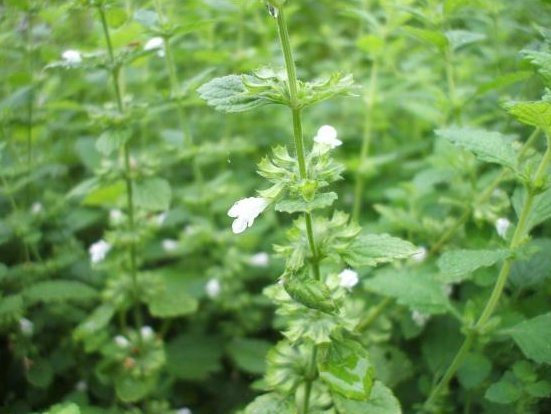

Short pedicels are crowned with axillary bunches of small white flowers, which can also have pale pink or purple tones. The flowers have four stamens, the upper four-part ovary of the pistil is on a long column. The flowering of lemon balm marks July and August of the second year of growth.
A large, with black sheen, four-root fruit, which matures in August-September, is ovoid. Before flowering, the herb smells like lemon. When the bloom ends, the fading odor becomes unpleasant.
Beneficial features
The fragrant plant not only has a unique scent, but it is also very useful. The delicate leaves of the plant contain large amounts of vitamin C, essential for the immune system, and essential oils. Due to its composition, the plant has always been popular not only in cooking, but also in medicine and cosmetology. Tea or a tincture of lemon balm will help get rid of poor appetite, insomnia, eliminate headaches, relieve stress, and eliminate depression. Melissa retains its medicinal and culinary properties for a long time. Even after 24 months, dried lemon balm herb will still be fragrant and healthy.
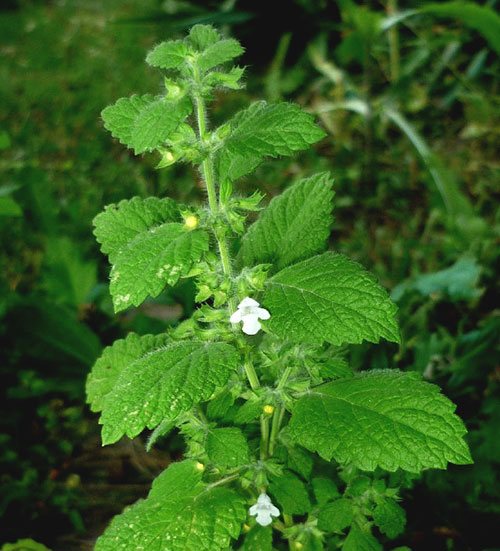

Contraindications for the use of lemon balm
Lemon balm is one of the most effective medicinal plants, therefore, it can be taken only according to indications and not exceed the recommended doses. Also, decoctions and infusions of lemon balm cannot be taken orally for such diseases:
- epilepsy;
- hypotension;
- exacerbation of stomach or intestinal ulcers;
- liver failure;
- individual intolerance.
When treating with lemon balm, there may be some inhibition of reactions, drowsiness and decreased concentration. Therefore, the use of decoctions and infusions of lemon balm should be abandoned by drivers, people working with dangerous mechanisms and at work requiring maximum concentration of attention.
Read also: The subtleties of planting and growing Canadian roses
Features of varieties
Melissa is a popular aromatic herb. Today, many varieties have been bred, but the most favorite among summer residents are lemon, lime, erect, pearl. Breeders have also developed decorative varieties. For example, the Pure Gold variety has yellow leaves. In the sun, they play with rays, shimmer and shine. Such plants are used to create flower beds and rockeries. It is not suitable for use in food or for the preparation of medicinal tinctures. The variegated variety has a rich aroma. The plant is easy to care for and can even be grown in flowerpots on the windowsill. Variegated lemon balm has small leaves with a rich green color. In European countries, lemon balm is grown on a field scale. It has become an irreplaceable spice. In our country, lemon balm is grown only for our own needs. If you have not yet settled lemon balm in your summer cottage, be sure to do it. Just a few leaves of a fragrant plant can add a special feature to a familiar dish.
Growing mint (lemon balm) in an apartment
Mint is a perennial plant and is most often grown in home gardens. Here it grew under the steps in the form of wide bushes, but now, when there is no longer a vegetable garden, and fresh mint leaves are required to decorate my culinary masterpieces, I decided to grow mint in my apartment.
The easiest way to move regular garden mint indoors is by dividing a bush or rooting a cutting. But I have neither the one nor the other. But there is a great desire to grow mint from seeds. Therefore, in the coming months, you and me can observe an unusual experiment: growing mint in an apartment.
For this I used the seeds of Lemon Melissa, Peppermint and Mila (Oregano), she is also Oregano.
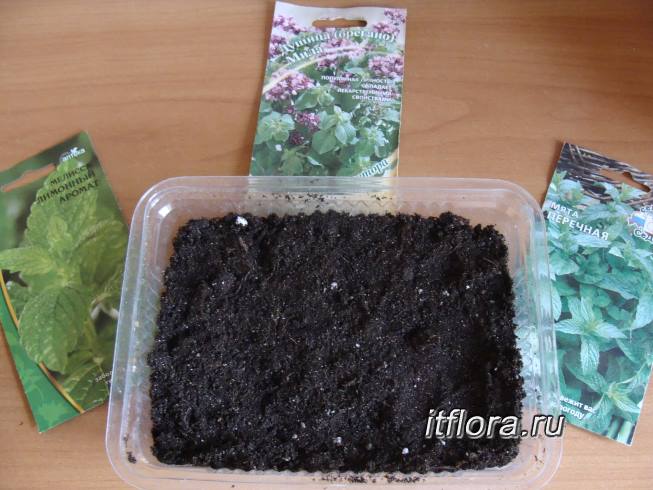

March 25.Taking a small bowl made of transparent plastic, I poured Terra Vita universal peat soil into it (I plant everything only in it - I really like it) and poured it with warm water.
I unpacked the bags of seeds and sowed in the ground in 3 rows. By the way, lemon balm seeds are much larger than others. Lightly sprinkled with earth, covered with a bag and put in a warm place.
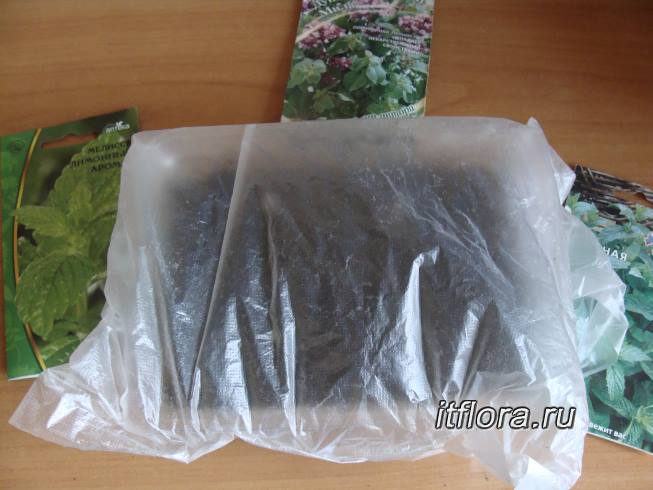

30th of March. Mila's planted row ascended.
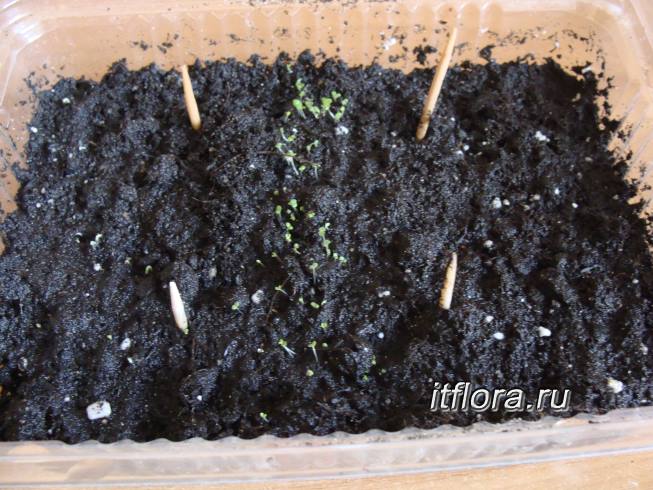

April 1: lemon balm sprouts appeared. Peppermint is lagging behind in development.
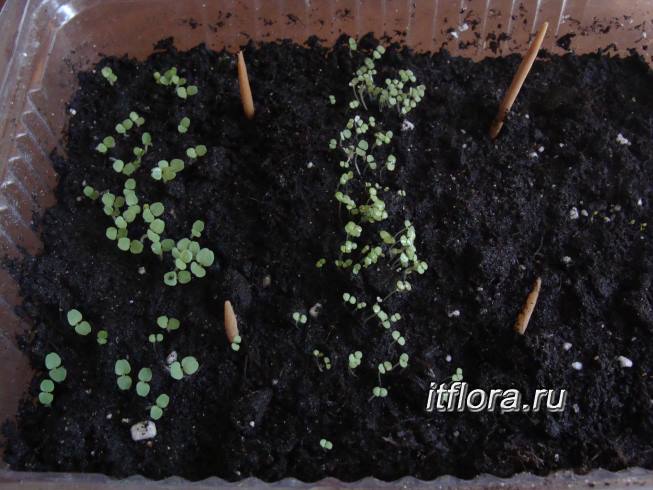

April 6. the larger bushes of Lemon mint got out 2 real, but still small leaves.
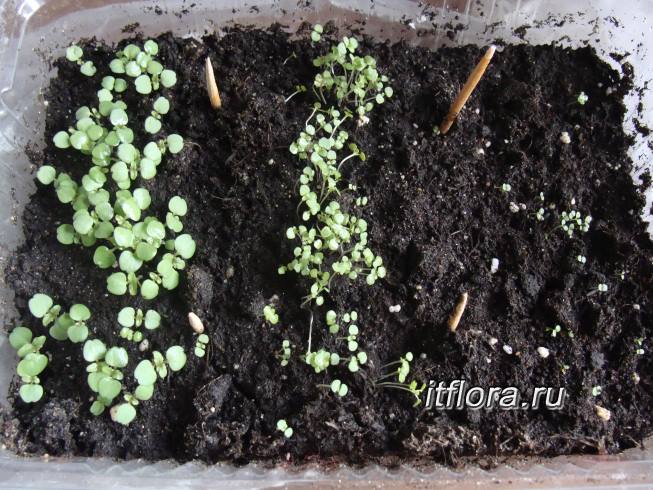

April 10: Lemon balm develops very quickly, look at which bushes have grown - and the leaves have already acquired a characteristic aroma.
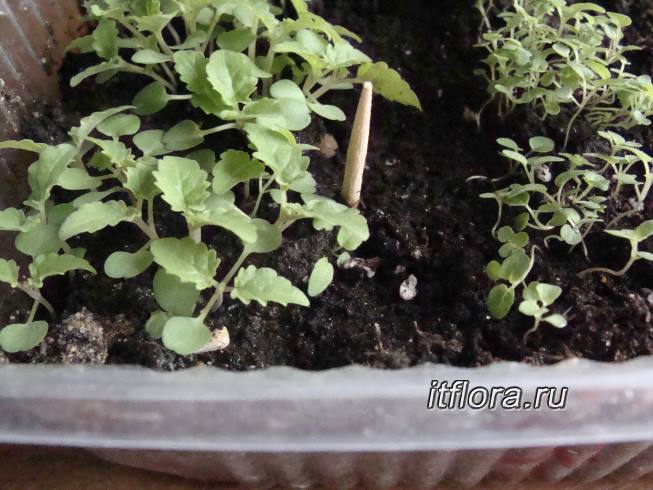

And this is the whole "bed". Probably, soon it will be necessary to plant lemon balm - she is cramped.
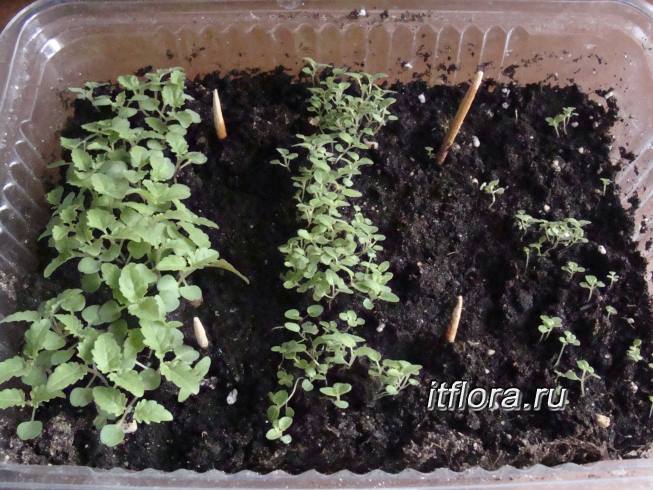

April 17 - Melissa actively started to grow and already interferes with the neighbors - therefore, she planted it from the common "garden"
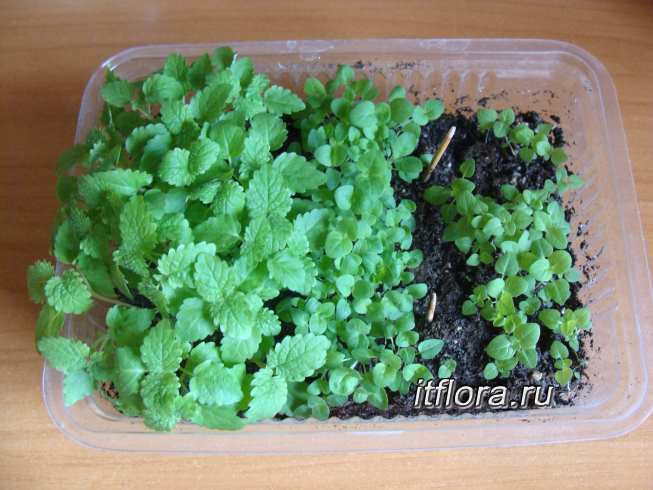

Since of all three mints, I liked lemon balm the most in terms of smell, so I transplanted all the roots into separate shallow containers.
It turned out 4 containers for cutting and planted 3 roots in a pot to leave for the winter.
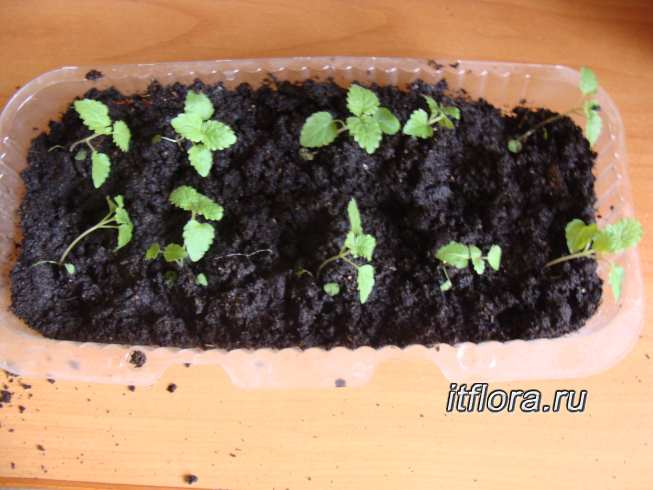

May 6 - mint bushes grow in a pot. Mila and peppermint were never transplanted - until they remained in a small tray.
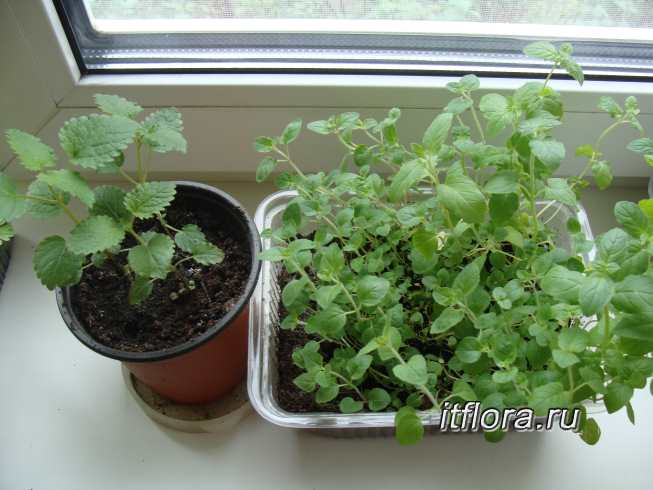

May 19 - due to lack of space on the windowsill, I decided to cut the first bed of lemon balm. Here it is - the first harvest.
Seed reproduction
The easiest and most affordable way to grow this herb in a summer cottage is by seed reproduction. The seeds can be harvested from an adult bush or purchased from a specialized store. Melissa, growing from seeds of which allows you to enjoy freshness throughout the warm period, is not demanding on soil, moisture, tolerates low temperatures perfectly.
The plant is not afraid of frost and feels great even at high temperatures below zero. That is why you can sow seeds at any convenient time - even in the autumn. There are no clear restrictions on sowing aromatic herb seeds. Seeds can be germinated in spring, summer and even late fall. Sowing rules for lemon balm seeds:
- Grows in luxurious bushes. Therefore, it requires enough space for full development. When planting seeds in rows, it is necessary to provide a row spacing of at least 30 cm.
- Sow at the rate of 2 g dry seeds per m2.
- The seeds do not need to be deeply buried. They are sown to a depth of no more than 2 cm.
- The seeds are durable. Even after 3 years of storage, they will give friendly and uniform shoots.
- Dry seeds are sown in open ground. Do it in the spring. For summer planting, it is recommended to use seedlings.
Lemon balm seeds are very small, and seedlings do not differ in abundance at the first stage of growth. That is why professionals recommend mixing lemon balm seeds with other crops, for example, with salad or radish. The seeds are mixed 2: 1 - for 2 parts of an additional culture, 1 part of lemon balm. This approach will allow you not to lose seedlings. Until the culture rises and grows to a noticeable size, the radish or salad can already be eaten. In the first year of growth, young plants bloom but do not set seeds. A scented crop takes time to gain strength and form a mature shrub, ready to seed. Melissa, a simple cultivation and easy care of which allows you to enjoy aromatic tea, gives a full harvest only in the second year of growth. The best option for planting lemon balm from seeds is growing seedlings.
Growing features
Melissa can grow on the windowsill for many years, it is unpretentious in care. Home environment reduces the influence of negative factors. With sufficient soil nutrition and proper care, the plant does not get sick, it is protected from pests. You can harvest the crop in the second year after planting.Before flowering, the smell and taste are most pronounced, therefore, it is recommended to break off the formed inflorescences if the lemon mint is higher than 20 cm in height. Pruning the branches will form a lush green bush.
In one container, it is permissible to arrange 2-3 seedlings in 1 row at a distance of 15-20 cm from each other.
Growing lemon balm at home for a long time will allow the implementation of a number of agrotechnical measures:
- sufficient watering;
- loosening as a dense earth crust forms;
- maintaining an optimal microclimate;
- making dressings;
- timely pruning of shoots.
Landing technology
Cuttings are considered to be the easiest breeding method, especially for home breeding. A twig 8-10 cm long can be cut from any adult bush or bought in a store, it is important that there is an internode on it. It is advisable to put in water or wet sand on the day of cutting. The roots will appear in 1.5-2 weeks. Plant the rooted cuttings in the prepared soil mixture, water. The fact that the seedling has taken root will become noticeable by the formation of new leaves.
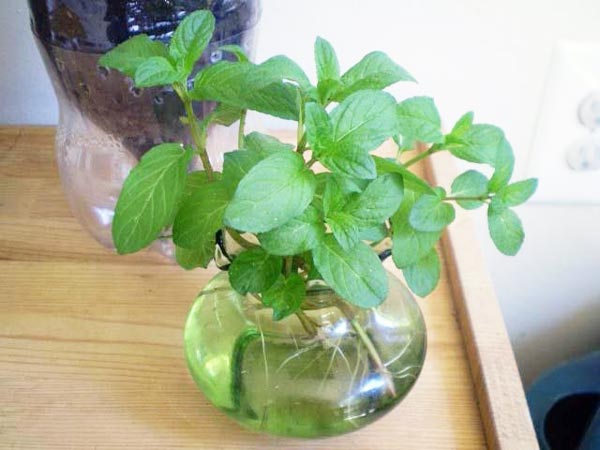

There is another way to plant culture. For home breeding of lemon balm in the spring, bend the young shoot of an adult plant 10-15 cm long to the ground, pin it down with a twig or press it down with a small stone, sprinkle it with earth. Do not forget to water, remove weeds around. After a year, separate the new bush from the mother plant, plant at home.
Watering mode
It is possible to grow lemon balm on the windowsill only with regular watering, since excess liquid flows into the pan and evaporates, and it does not rain at home.
Read also: Planting and caring for the red root (tseanotus)
Fertilizing the soil for home cultivation of lemon mint is required 2 weeks after planting by a vegetative method or after the first shoots appear in the seed method of propagation. Subsequent procedures are carried out before the flowering period after each pruning of branches.
For feeding use:
- folk remedies - eggshells, herbal infusions, tea leaves;
- complex mineral fertilizers - superphosphate, urea, ammonium sulfate, potassium salt.
Home cultivation of lemon balm is widespread due to the fact that the culture is unpretentious and adapts well to a new environment. Creation of a favorable microclimate and adherence to the main agrotechnical measures contribute to the receipt of fresh spicy greens all year round.
Planting seedlings in open ground
Melissa is demanding on the spot. To plant a plant, you need to choose a space under the tree. But the place should not be dark, direct sunlight can also have a detrimental effect on the plant. The aromatic culture feels perfect in partial shade. The soil for planting seedlings is prepared in advance. Melissa prefers slightly acidic sandy loam soil. Preparation of a place for planting lemon balm seedlings:
- In the fall, a garden bed is dug under lemon balm, weeds and unnecessary roots are selected.
- Mineral fertilizers, rotted manure are applied.
- In the event that the soil is acidic on the site, the place for seedlings is drained with bricks or fine gravel. Acidic soil contributes to the formation of root rot - the plant sooner or later dies.
- Melissa loves the high ground. That is why the grass bed is made high.
Clay soil should be diluted with sand.
In the spring, the prepared bed should be cleared of weeds. Can be weeded by fluffing up the soil after winter rest. Mark the rows at least 30 cm apart. The ideal row spacing is 45 cm. Seedlings are planted in one or two rows in a checkerboard pattern. The distance between the plants should be 40 cm. If there is no need to save the planting space, the distance between the plants increases to 60 cm. In such “chic” conditions, lemon balm will be able to reveal all its advantages. Having room to grow will allow a strong and branched bush to form.The aroma of lemon balm is most intense and refined until the moment of flowering. That is why it is harvested before the formation of peduncles, trying to get the most refined smell. ...
Conditions for growing at home
Breeding lemon mint at home will allow you to have a fresh, aromatic spice on hand year-round. The creation of comfortable conditions will significantly reduce the care of the plant, the risks when cultivating in the open field. The culture does not tolerate drafts, sudden temperature changes, strong winds. In summer, it can be taken out onto the balcony, but must be protected from direct sunlight and bad weather.
Cultivating lemon balm at home involves:
- creation of an optimal microclimate (humidity, temperature);
- soil preparation, good drainage, capacity;
- pre-sowing treatment of seeds, rooting of cuttings or dripping layering in the country;
- adherence to the landing technique;
- providing proper care.
Illumination
Culture loves light, so it should be placed on southern, southeastern, or southwestern windowsills. It is advisable to shade from direct sunlight so that there are no foliage burns. Melissa, when brewed at home, also grows in winter, so you may need additional lighting for about 4-6 hours with a fluorescent or phytolamp at a height of 60 cm from it.
With a lack of light, the plant will not die, but it will stop growing, the leaves will become small with a low content of essential oils, of a lighter color.
Humidity and temperature
Requirements for soil and capacity for growing
Lemon mint prefers light, well-drained, nutrient-rich soils with neutral acidity. You can use loam as a base, adding sod soil, sand and mineral fertilizers. A versatile potting medium for indoor plants from garden shops is also suitable for growing lemon balm in a pot. Before use, disinfect garden soil and river sand in an oven at + 75-80 ° C. Pour expanded clay, broken slate or crushed stone as a drainage layer.
You can choose any capacity - container, box, long plastic or round pot. It is advisable not to use a wooden container, since it is difficult to process it from pathogenic microorganisms and it is not suitable for long-term cultivation. The main requirements are a minimum height of 15-20 cm and the presence of holes on the bottom. Before planting, wash the container, treat it with a solution of potassium permanganate, dry it. It is advisable to immediately plant in a large container to eliminate the need for picking and replanting.
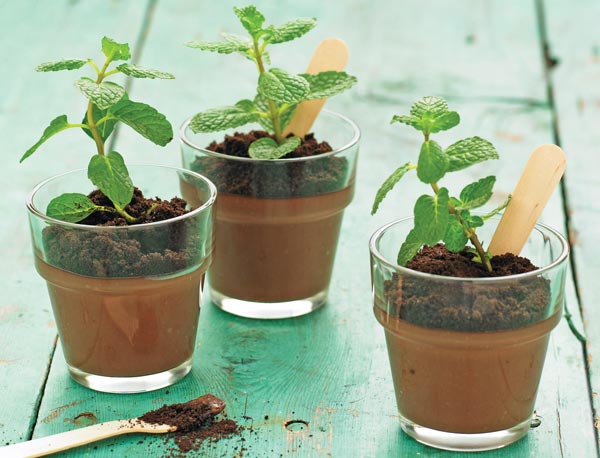

Agricultural technology of sowing lemon balm seeds
Although breeding with lemon balm seeds is not an easy task, it is the one preferred by professionals. After all, a bush grown from seeds is more resistant to adverse environmental factors. The lemon flavor in the seedling method is revealed much deeper.
Seed sowing technology:
- Lemon balm seeds are soaked for several hours in a weak manganese solution. A simple procedure will ensure the disinfection of seeds, elimination of fungi.
- Seeds are sown in prepared containers 0.5 cm deep.
- Crops are carefully moistened with settled water at room temperature.
- The boxes with seeds are covered with plastic wrap or glass, forming a kind of greenhouse.
- After 2 weeks, the first sprouts of fragrant lemon balm appear.
- After the formation of 2 leaves, the crops are thinned out.
Using this technology, you can grow lemon balm on the windowsill.
Melissa home, in a pot, on the windowsill - care, photo, reproduction
Botanical name: Melissa.
Melissa plant - family ... Lipoids.
Origin ... Mediterranean.
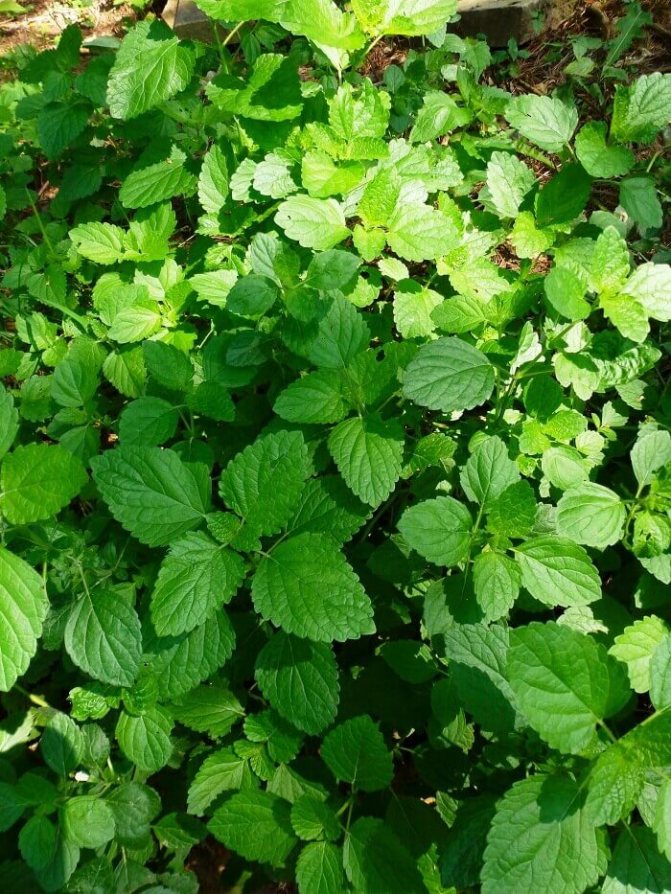

Description . Melissa - a perennial plant, in which, when frost occurs, the entire ground part dies off, and in the spring the plant begins to grow again from the underground root. Stems erect, branched, covered with pubescence.The leaves are arranged opposite, oblong-oval or lanceolate, up to 7 cm long, with pronounced veins, green, also covered with delicate pubescence, when damaged, they emit a very pleasant mint or lemon aroma. The edges of the leaf plates have small notches. In the summer months, small nondescript flowers appear in the leaf axils - white or lilac, male and female. There are attractive variegated plant forms.
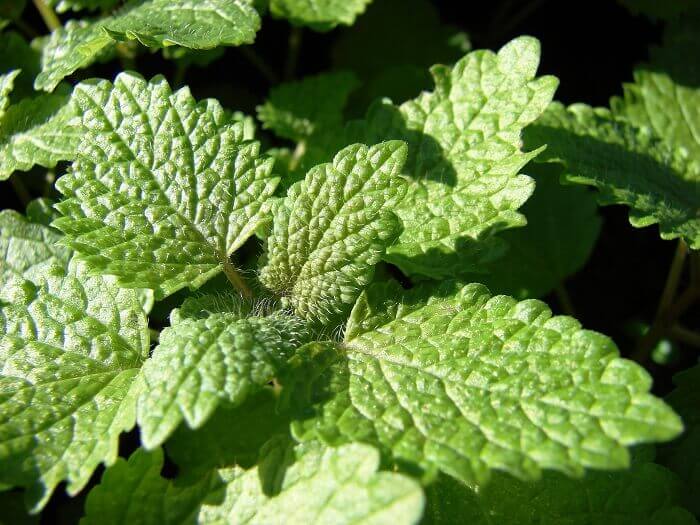

Height ... 70 - 150 cm, growing rapidly.
Care of young plants
- Melissa prefers bright areas for growth. Provide her with such a place, and she will thank you with fragrant greens.
- Melissa is demanding on soil moisture. In the summer, in extreme heat, it must be watered abundantly. When the temperature drops, watering the plants is stopped.
- Melissa responds favorably to timely pruning. In addition, removing greenery from the bush will delay the flowering period.
- Melissa loves nutritious soil and is grateful for the fertilization. You can use both mineral and organic fertilizers.
Melissa is an amazing plant that is very easy to grow in your own summer cottage. With very little effort, you can achieve a high yield and enjoy the lemon-honey scent of an exquisite plant all year round.
Welcome friends on the site advice to gardeners. Melissa is a perennial culture that is not only beneficial for our body, but also has a pleasant, sophisticated aroma.
We used to drink tea with mint, but if you add a pinch of lemon balm to it, it will acquire a richer and more aromatic taste and, moreover, you will sleep like the dead.
It also turns out excellent preservation with lemon balm leaves, soups, drinks. As a medicine, it has a diuretic, analgesic, diaphoretic effect and helps to normalize the stomach.
Usually summer residents do not do without such grass, sow lemon balm in the garden and enjoy the harvest for several years in a row. But apartment residents are much more difficult, the question is, how to grow lemon balm at home?
Tea
An excellent antibacterial and antiviral agent is green tea with lemon balm added to the tea leaves. In this case, it is advisable to drink it with honey.
Lemon mint is easily grown right in the country and in the garden. It is better if it grows in the shade. Already from May, you can collect the leaves a little bit to add to tea and preparations for the winter.
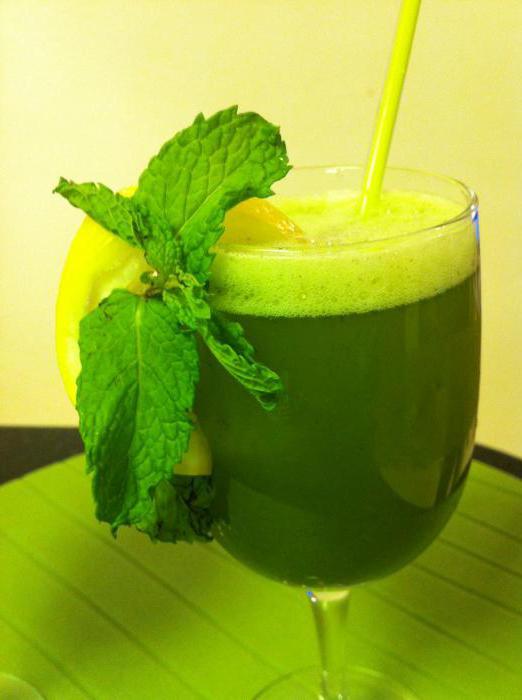

This tea will be useful, but it should be consumed in moderation. Two cups a day is a perfectly normal and acceptable dose.
This drink will not only calm down with a nervous state and invigorate with depression, but will also have a general tonic effect on the body, improving appetite and normalizing cardiac activity.
To prepare it, you must adhere to a number of rules:
- such tea is brewed in porcelain or glass dishes;
- water should be boiled, cooled to about eighty degrees;
- green tea and lemon mint are taken in equal quantities: one teaspoon of ingredients will be enough for one liter of water;
- It is best to consume freshly brewed tea, rather than already used or brewed for too long.
Growing lemon balm on a windowsill
Before you start growing lemon balm on the windowsill at home, of course, you need to purchase high-quality, fresh seeds. At the beginning of March, we fill a small box with loose soil, make shallow pits about 0.5 cm, and so that the distance from one hole to another is at least 5 cm.
Spill the soil with warm water and sow seeds. Until the first shoots appear, it is necessary to moisten the soil every two days, but not flood it. Because too wet soil often infects the plant with a fungus.
Seeds usually germinate for about 10 days, but sometimes up to 20. It is necessary to ensure that the temperature is above 10 degrees for a month.In early May, the sprouts are planted in long flowerpots, at a distance of 15 cm from each other, preferably in one row and placed on the balcony.
When real leaves appear, the plant can be thinned out, it does not need a pick. Now you also know how to grow lemon balm on a windowsill.
In the first year of life, leaves appear near the roots. A riot of greenery and flowering will be only next year, then it is possible to harvest, only this must be done until the moment when the plant throws out the buds.
At home, growing lemon balm is not a very easy task, but still, real. It is desirable that the flower grower with the plant be in a sufficiently lit place, but if there is none, maybe in a semi-dark place. The plant sometimes reaches a height of just under half a meter.
Watering lemon balm is necessary three times a week. The most useful in the plant is the leaves, so for better bushiness, you need to avoid flowering and cut off the buds when the plant grows about 20 cm.
Over the summer, you can trim the leaves up to 4 times as needed. Cut it when it is 45 cm high, but not completely, but leaving 10 cm.
You can leave the plant on the loggia until the first frost, that is, until late autumn. An excellent fertilizer for lemon balm is egg shell tincture and tea leaves.
How to grow mint at home on a windowsill: grow mint in a pot all year round.
On a summer evening, sitting comfortably in a sun lounger, it is pleasant to have a cup of tea flavored with green leaves of fragrant mint. Such a pastime is not only pleasant, but also useful from the point of view of maintaining your health at the proper level. Although, why are we talking about summer? After all, you can enjoy this noble drink anywhere, at any time of the year, whenever you wish. And for this you only need one thing - to have fresh mint at your disposal all year round. The statement is interesting, but where can you find mint leaves in winter, on snowy ground? But you don't have to look for anything if the fragrant plant grows in a pot on the windowsill. And in order for it to grow, you only need to be a little guided in the question of how to grow mint at home in the winter. And why not? If in "wild" conditions mint grows, then in greenhouses it will grow even more so. Competently select all the necessary components, comply with the conditions responsible for its correct growth - these are all the requirements of home growing. Now everything said in detail and in stages. What mint is grown from There are two ways to breed mint indoors. The first way is from seeds. Simple in essence, but requiring some knowledge of the "mint" varieties. Since the seeds will be purchased, you should initially know what to buy. Not knowing the grade, it's hard to get what you want. On a note. Apple mint varieties are an excellent seasoning for compotes, jelly and jam. Field mint will be useful in tonic drinks. For those who love the taste and smell of mint without "extreme", that is, with a low menthol content, we can recommend varieties of curly mint. The second method is growing from a cuttings. On the one hand, the option is troublesome, planting material needs to be harvested, but on the other hand, we will get mint faster, because nothing is germinated, but only grown and the variety will be what we want. We take the cuttings from the plant that we see and which we have tasted. How to plant seeds Consider how to grow mint on a windowsill from the most convenient planting material - from seeds. The procedure is simple. Purchased or personally collected seeds are taken, laid out in pits or grooves. To make it less work, and it will be more convenient, you can gently press the seeds into the soil, instead of spreading them out, and then covering them with an additional layer. Planting depth 0.5 centimeters. For the full germination of planting material on the windowsill, special conditions are not required.A normal room temperature of 20-25 ° C and moist soil are sufficient. By the way. It is recommended to water the planting through a sprayer with fine spray, so as not to wash all the seeds up. To accelerate the germination of future mint, it is allowed to cover the “vegetable garden” with a film, but with regular airing. Planting cuttings The next method to grow mint at home quickly and efficiently is cuttings and roots. It will be possible to indulge in fragrant tea in two to three weeks. But first, prepare the material. For breeding mint at home on the windowsill, you can choose either the upper cuttings or the lower ones. In the first case, the top of the plant is cut off by 8-10 centimeters. In the second case, a part of the rhizome is taken for the "seedling". Or the whole root if it is small. Cuttings from the top of the mint are pre-germinated in a container with water or wet sand. After the emergence of young roots, they are transferred to a separate container (pot, box) for further growth. Cuttings from the root system are planted directly into prepared, well-moistened soil. Everything else is the same as with seeds, but it is not necessary to cover the "bed". Soil and container - the right choice For planting mint seeds, it is recommended to take one large box, the size of the window sill. First, all planting material is planted in one container. After the first greenery appears, each plant is transplanted into an individual pot. But if desired or necessary, everything can be left as it is, removing the most frail plants from the general growth and planting healthy ones from one another at a distance of 5 centimeters. For cuttings, the pots are used immediately. No plant transplant is foreseen here. On the ground. Mint loves fertile, loose soil. To grow mint at home on a windowsill in winter, you can use ordinary garden, well-fertilized soil. It's not bad if it is mixed with sand. A good option is peat soil. On it, mint also gives an excellent harvest. In the case when there is neither one nor the other, garden soil (2 parts) is taken and mixed with humus (1 part). And the last is the purchased substrate. Ideal for city dwellers. Be careful with garden soil! It requires additional processing with high temperature in the oven, potassium permanganate solution or boiling water. After all, how to grow a mint on a windowsill healthy and beautiful if the soil used is initially infected with both diseases and harmful insects. "Disinfection" will not allow pests from the garden to move into the box on the balcony - the plant will not hurt. When filling the containers with the prepared substrate, do not forget about creating a drainage layer at the bottom of the pots or box. A layer of two to three centimeters of expanded clay or fine gravel will be enough to remove excess water from the soil. Providing optimal conditions for growing mint on the window Lighting The place where the pot with the planted seeds or cuttings will stand should be light, but not in direct sunlight. Penumbra will also be good. Temperature Depends on the illumination of the "vegetable garden". 20-25 ° C heat without drafts is just the norm if the pots or boxes are in a well-lit place. When daylight is not enough, it is recommended to lower the room temperature to 15 ° C or put young greenery on a less heated balcony. In low light and high temperatures, the mint stalks will be thin, and the leaves will be defective. Watering Since growing mint at home can be done at different times of the year, watering the plant should also be different in intensity. In winter, the beds are watered sparingly, avoiding an excess of water and the formation of dirt. In summer, the regularity of watering is slightly increased due to the increased ambient temperature. But even relatively increased watering should not lead to the plant's root system being waterlogged. Top dressing Winter mint dressing is not required.Unless, feed the cuttings at the beginning of their vegetative period (when the first young shoots appear). For feeding, it is recommended to use a solution: 1 gram of urea per 1 liter of water. In the summer, it is allowed to apply mineral fertilizers, but in a sparing, safe amount for health and only at the stage of the appearance of the first leaves. They planted, germinated, grown, harvested - easily, quickly, pleasantly. Mint is probably the only plant that grows and cares for at home brings real pleasure to gardeners. A beautiful view and a pleasant aroma in the room, in addition to the beneficial qualities that contribute to the prevention of a wide variety of diseases, make mint indispensable when there is a lack of truly fresh fragrant greens.
Garden on the window, what else can you grow on the windowsill
At home, on the windowsill, you can grow not only lemon balm, but also onions, garlic, parsley, salads, and even tomatoes and cucumbers.
The main conditions for such cultivation are lighting and temperature. Usually, if the seedlings do not have enough light, they stretch out, become frail and often die, or if they survive, then there is little use from it.
If the temperature in the room is below 17 degrees, the roots of the plant rot. If you can create the right conditions for the plants, then you can start the growing process itself.
You need to choose seeds for sowing of early varieties and undersized ones. Before planting, the seeds are usually soaked in manganese, you can just in water for three hours.
Fill flowerpots with potting soil, carefully sow seeds, try to do it evenly. And sprinkle a little earth on top. Dill and basil seeds sprout quickly enough.
If you purchased seedlings such as mint, rosemary, then make small holes in the pots and deepen the roots of the plant into them by 2 cm and at a distance of 5 cm from each other.
Remember to water thoroughly until the seeds begin to germinate. Then you can water less often. You need to watch the plants and when you notice that they are stretching to one side, unfold the pot so that the stems are aligned.
How to plant green onions. You can even put it in water. To do this, take an ordinary large onion, you can take several, some kind of vessels with cells, for example, for ice and put the onion there, only so that the base of the bulb is not in the water, only the place where the roots should be.
They will soon grow up there. The roots will be saturated with water, and the greens will grow, it can be cut off, and it will quickly grow again. Periodically change the water to fresh, and when you see that the onion is soft, replace it with a new one.
Melissa needs:
- fertile soil;
- a lot of light;
- sufficiently plentiful watering and spraying;
- systematic pruning;
- compliance with the temperature regime (18-20 degrees);
- regular feeding.
A plant can grow in one place three to four years
... After that, it requires renewal and transplantation. In order for the bush to be healthy and strong for several years, it is recommended to plant it in the spring.
Growing lemon balm on a windowsill is not a troublesome business. It feels great in a pot, like any houseplant. True, the lemon balm bush will be low, but lush and thick, if it has enough light, moisture and nutrients, that is, competent care for the lemon balm is provided.
Melissa on the windowsill. Photo
In the winter season, growing lemon balm on the windowsill is not much different from the usual one. Lack of sunlight will reduce the amount of greenery, change its color, but not affect the quality.
Lemon melissa: growing
Melissa grows poorly on heavy soils, preferring rich clay and loamy soils. In the southern regions it winters well, but in the middle lane it freezes out for the winter.
Reproduction of lemon balm
most often carried out by dividing the bush or seeds, less often by cuttings and jigging.Lemon balm seeds germinate at a temperature of ten to twelve degrees, the optimal temperature for growth and development is considered to be 20-25 degrees.
Melissa is demanding on light, it is better to grow it in open, well-lit areas. You can also plant lemon balm in a shaded area, but in this case, the content of essential oils in the plant will be low.
Growing lemon balm
in one place you can spend up to ten years, but if high yields are your priority, you need to update the bush every four years.
Lemon balm varieties
In culture, two varieties of German selection are widespread - creeping Quedlinburg and upright Erfurt lemon balm. These varieties differ not only in appearance, but also in winter hardiness and flowering times. However, in the gardens of amateur gardeners, as a rule, not "purebred" varieties grow, but local forms of lemon balm.
Planting lemon balm
Before planting lemon balm
the soil should be prepared: in the fall, fertilize with manure, dig up, and in the spring they enrich the soil with mineral fertilizers. Potassium salt and ammophos are best for lemon balm.
When growing melissa seeds
seedlings are prepared first. The seeds are sown in March. Seedlings are thinned out by four to five centimeters and a solution of nitrogen fertilizer is added two to three times. Lemon balm seedlings aged 30-40 days are planted according to a scheme of about 70x25-30 cm.
When reproduction of lemon balm by dividing the bush
it is best to take planting material from 3-4-year-old plants. In early spring, the bush is dug up and divided into parts, each of which should have roots and 2-3 buds. Planting lemon balm by dividing the bush is carried out in the same way as in the seedling method. Already in the first year, a solid harvest of green mass is harvested from the transplanted plants.
Melissa care
Melissa care is generally simple. Several times per season, the land around the plants is loosened, weeds are removed, and watered 3-4 times. You can feed lemon balm twice a season: for the first time - 20 days after planting lemon balm (potassium salt and ammophos), the second time - after cutting the greens, with the same fertilizers. You can combine watering and feeding lemon balm.
How to collect lemon balm?
For consumption fresh lemon balm, cut it, of course, as needed. But if you plan to prepare lemon balm for the winter, then it is better to cut it in the budding phase or at the very beginning of flowering. This can be done twice - in July and August. If you grow lemon balm seedlings, then you should cut it in the second year, and when dividing the bush - in the first year.
Melissa needs:
- fertile soil;
- a lot of light;
- sufficiently plentiful watering and spraying;
- systematic pruning;
- compliance with the temperature regime (18-20 degrees);
- regular feeding.
A plant can grow in one place three to four years
... After that, it requires renewal and transplantation. In order for the bush to be healthy and strong for several years, it is recommended to plant it in the spring.
Growing lemon balm on a windowsill is not a troublesome business. It feels great in a pot, like any houseplant. True, the lemon balm bush will be low, but lush and thick, if it has enough light, moisture and nutrients, that is, competent care for the lemon balm is provided.
Melissa on the windowsill. Photo
In the winter season, growing lemon balm on the windowsill is not much different from the usual one. Lack of sunlight will reduce the amount of greenery, change its color, but not affect the quality.
Breeding new lemon balm bushes
Let's figure out how to grow lemon balm from seeds and how to increase the amount of a favorite plant in other ways. This can be done in different ways:
- dividing the bush;
- layering;
- stem cuttings;
- lemon balm from seeds.
Division
an adult bush is produced in the spring. To do this, the root system is freed from the ground, cut into several parts with buds and planted in a permanent place.
Via layering
the plant is bred before flowering. Strong young shoots are bent to the ground with a staple, sprinkled with soil and await rooting. Two weeks later, a new bush is cut off with a pruner and transplanted into a pot or open ground to a new location.
Cuttings
used at the first stage of breeding lemon balm, in the absence of an adult bush in the garden. The tops of the purchased plants are cut off and placed in a container with water. When roots form on the branches, they are planted in the ground and placed in a dark place. After the appearance of green shoots, the plants are taken out into the light.
Growing lemon balm on a windowsill. Photo
How to grow lemon balm from seed
? This process takes time and patience. But the quality of the green mass of lemon balm from seeds will be excellent.
To grow an adult bush, lemon balm seeds treated with potassium permanganate are sown into the ground to a depth of 1-2 centimeters, tightly covered and placed in a warm place.
How to grow lemon balm. Photo
The emerging seedlings are transplanted into well-moistened drained soil.
For this purpose, use a large container for a permanent place of plant life or small cups.
Dive shoots of lemon balm from seeds should be after the formation of two to four leaves. In about one and a half to two months, lemon balm from seeds will delight you with juicy fragrant greens.
Planting methods of lemon balm
Before planting seeds, you can hold them in a solution of potassium permanganate. Processing time is an hour or two. Thus, prepared, they are planted to a depth of no more than one centimeter, and then the container is closed with a plastic lid, or polyethylene and transferred to a warm place.
The emergence of sprouts can be expected on the seventh to tenth day. Sometimes up to two weeks.
The soil in the container should not dry out or become moldy. Controlling the moisture level is very important - the germination of seeds depends on it. When sprouts appear, thinning is imperative.
Some of the rules for planting lemon balm must be remembered and, if necessary, grown lemon balm seedlings in the garden:
- the distance between the rows of plants should be about 25 centimeters;
- seeding density 1.5-2 grams per square meter;
- so that the seedlings are not lost among the weeds, it is recommended to mix the seeds with lettuce or radishes. These crops ripen much faster, and when the lemon balm grows up, they can be safely removed;
- plants calmly transfer sowing to open ground;
- the plant is perennial and can grow for three, or even four years in one place (or in one pot), however, after it, it requires renewal, transplantation.
Gradually, the plants gain strength and release leaves. When the fourth appears, this is a signal that the time has come for a pick. If the plants are intended for growing at home, then they are seated one at a time in pots up to two liters and at least fifteen centimeters deep. The first leaves from these seedlings can be obtained in two months.
If further planting in open ground is planned, the plants can be transplanted into a temporary container, six to seven shoots per pot.
The time for planting lemon balm in open ground usually falls in the spring - late April or early May, depending on the air temperature. Remember that you must first spray the bushes with an anti-stress drug. The lemon balm bed should be drained so that moisture does not linger in the soil.
Under each bush, you can throw a tablet or two drugs Glyocladin. This will help protect young plants from possible root rot. Sprinkling can be continued in the garden, especially if the weather is dry.
Melissa twins. What can be confused with
Melissa is often confused with other plants. These twins include:
- catnip
- snakehead moldavian.
Let's try to understand their differences.
Melissa is called "lemon mint" by many. In fact, these plants have nothing in common, except for external similarities. mint
and medicinal perennial lemon balm.
The herb called "catnip
"Can also be mistaken for lemon balm. The similar smell of these plants is misleading. In order not to confuse lemon balm with "catnip", you should get acquainted with the fundamental differences between them.
- The scent of lemon balm is delicate, reminiscent of the scent of lemon. The cattleman, on the other hand, smells rather harsh.
- White lemon balm flowers are located in the axils of the plant, and blue catnip inflorescences are in the upper part of the shoot.
- Rounded lemon balm leaves are even at the edges, and oblong catnip leaves are serrated.
- Lemon balm seeds are elongated, and catnip seeds are rounded.
Catnip grows everywhere. This herb is used for cooking and beauty products. It has medicinal properties: it improves appetite, cures cough, relieves worms.
Moldavian snakehead
or "Turkish lemon balm" - an annual plant found in Western Siberia and southern regions of Russia. The essential oils found in snakehead greens are reminiscent of the scent of lemon balm. But its smell is stronger and more pungent. Turkish lemon balm is a favorite of bees and an excellent sedative.
In order not to make a mistake and plant exactly what you need on your site, carefully study the inscription on the package with seeds when buying. For example, lemon balm in translation into Latin is called Melissa officinalis, catnip - Npeta catria, Moldavian snakehead - Dracocphalum moldavica.
Botanical characteristic
Melissa officinalis - height from 30 cm to one and a half meters, the stem is straight, branched, tetrahedral. The leaves have a petiole - the stem to which they are attached is oval in shape, with grooves along the edges. The surface of the grass is covered with fine hairs. Melissa flowers are tiny, on short pedicels, pale crimson, light lilac or white. They are located in the axils of the upper leaves of the plant.
The healing herb pleases with flowering from the second year of life in the second half of summer.
The fruit is very interesting in shape. It consists of 4 oval nuts, light coffee color.
Melissa contains an essential oil that has a pleasant light lemon scent. The fragrance is strongest before flowering, and then the smell becomes much weaker and even becomes unpleasant. Lemongrass is home to the eastern Mediterranean. This wonderful herb was grown two millennia ago in ancient Rome. It was from there that the plant got to the rest of Europe.
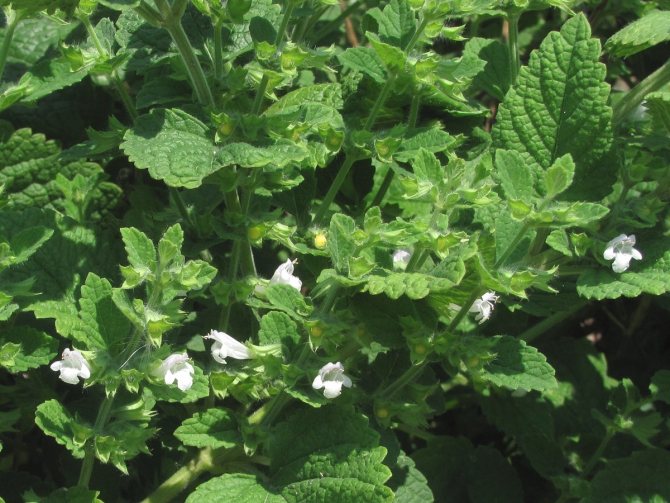

What does lemon balm look like and how is it different from mint?
Health-conscious people actively consume healthy herbal teas. Two fragrant herbs are especially popular: lemon balm and mint, which are often grown in the garden.
The leaves of these herbs are similar, they are often confused, so you need to know how mint differs from lemon balm. Let's look at these differences in a table.
Choosing the right sort of lemon balm
Several varieties of this extraordinary herb are known. Each variety of lemon balm has its own individual characteristics, differs in odor shades, leaf shape, bush size, flowering period. The most beloved varieties include several varieties:
- upright;
- Tsaritsinskaya;
- pearl;
- lime;
- lemon;
- freshness.
Melissa with the beautiful name "pure gold" is less common. This variety has an unusual light yellow color of leaves, covered with fine villi, shimmering in the light of sunlight.
Variegated lemon balm gets its name from the dark, golden-streaked color of the leaves. The herb of this variety has a strong smell and unpretentious character. It can be grown both outdoors and at home.
How to plant lemon balm at home in a pot
Lemon mint is an unpretentious perennial herb that grows well outdoors. Indoor lemon balm does not require special care also when breeding at home. The external difference between a pot spice and a garden spice is the size of the bush. The first is slightly lower, with a favorable environment, forms more frequent and larger leaves, which increases productivity.
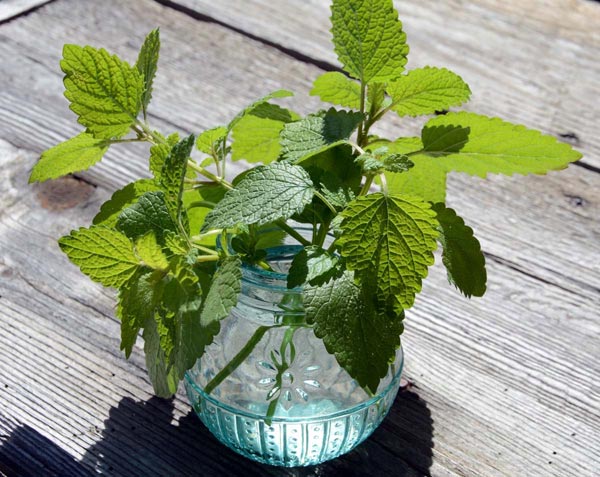

Flowering features
The first bloom depends on the growing method... A plant grown from seeds undergoes a long adaptation to new conditions (at least a year), so you should not expect flowering from it at this time. In other cases, flowering in the first year is also very rare.
The first flowers appear in the axils of the leaves and there are few of them. The petals are lilac, pink or milky white. The following years, melissa pleases with a more abundant bouquet.
Having received its name in honor of the ancient Greek nymph Melissa, the plant to this day does not cease to be a real find for lovers of sophistication. Subtle notes of mint and honey heal, soothe, give food and drinks a special piquant taste and unforgettable aroma. Try to grow this little miracle on your plot or in your house - you will definitely not regret it!
Care features
Many gardeners mistakenly believe that once planted, lemon balm can grow like a weed without the need for maintenance. However, an undemanding culture still needs a few basic activities for wellness:
- Timely and competent watering - in the heat, lemon balm is watered every two days, in cool cloudy weather - twice a week. Excessive moisture stagnation leads to root rot, so waterlogging should be avoided.
- One-time feeding - every spring at the beginning of the growing season, under each bush, a bucket of mullein solution is added with the addition of nitrogen fertilizer. In the future, to maintain the nutritional value of the soil and preserve moisture, the root zone of plants is mulched with humus or old peat.
- Every 3-5 years, the bushes are rejuvenated by dividing, otherwise the lemon balm leaves become coarser and smaller, and the plant's yield gradually decreases.
- To protect lemon balm from winter freezing, at the end of autumn it is huddled high, after cutting off the aerial part, and then covered with a layer of fallen leaves.
With proper care, lemon balm actively builds up its vegetative mass and blooms profusely.
Then you will immediately feel its aroma. Although in appearance lemon balm is completely inconspicuous, the wonderful smell of the leaves makes it a welcome guest of any gardener and gardener.
How to dilute lemon balm on your site? What conditions does she prefer and what does she dislike at all?
You will get answers to these questions by reading this article.
Processing of the site for planting
Under natural conditions, lemon balm settles along the forest edges and slopes of shady ravines, therefore, on the personal plot for its cultivation, a place should be allocated for its cultivation in partial shade near outbuildings or under the crowns of fruit trees. The best soils for it are loose, humus-rich loams or sandy loams with a pH of 4.5 to 7.8.
At the end of autumn, the plot is carefully dug up, combining mechanical processing with weeding and moderately filling the soil with mineral fertilizers and organic matter. If the land on the site is too heavy, it is recommended to bring in several buckets of river sand during digging.
In the spring, when the snow completely melts and the soil warms up well, they form low ridges, carefully loosening the soil with a rake and breaking large clods of earth.
Anxious caring for the plant: expert advice
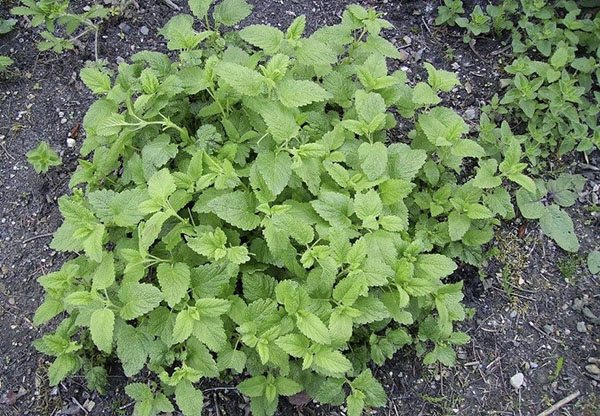

Some people think: if a perennial is unpretentious, then it does not need special attention. However, only the application of advice on how to care for lemon balm opens the way to magnificent landscaping of the site.
Thorough weeding of the soil
In order for young seedlings to develop quickly, gardeners carefully monitor the appearance of weeds.Usually they are pulled out by hand. After that, the soil is carefully weeded, providing the plant's root system with a fresh portion of oxygen. When it hardens, the procedure is performed several times a season.
Basic principles of watering
Lemon balm planting rules and outdoor care are not complete without proper moisture. At the initial stage, the seedlings are watered in small portions so that they gain strength and take root. Adult lemon balm needs water only during the heat of summer. Each procedure is accompanied by weeding of the topsoil. Some gardeners advise spreading mulch around the plant. As a result, moisture will be preserved and there will be no weeds. To do this, use compost or humus, which will simultaneously fertilize the soil.
Competent pruning
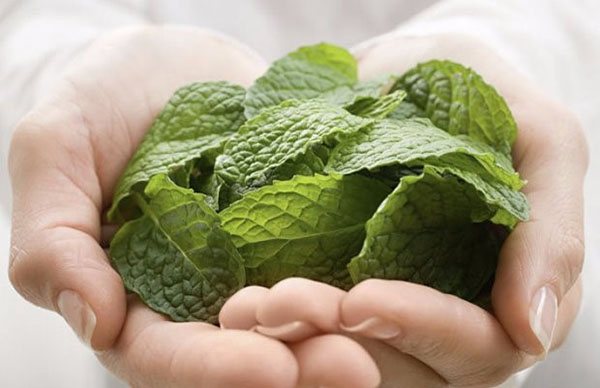

Since lemon balm is a branchy bush, it is not afraid of the planned removal of branches. On the contrary, after such a procedure, many young shoots appear, which turn the plant into a lush green ball.
Novice gardeners should readily apply the advice of experts on growing and caring for lemon balm. As a result, she will be able to delight her owners for about 10 years. Its fragrant foliage is an excellent remedy for treating diseases and promoting health.
Features of growing lemon balm - video
When and how to harvest?
You can harvest lemon balm 3-4 times a year from one bush. Experienced gardeners are advised to adhere to certain rules:
- Collect raw materials on a cloudy afternoon or early in the morning, immediately after the dew has melted.
- Do this not earlier than the beginning of flowering, ideally in the month of June. The leaves at this time are still very young, have a delicate aroma and delicate taste. Over time, the above characteristics increase, but the leaves become tough.
- Greens are cut at a height of 10 centimeters and above.
Diseases
Most often, the owner encounters two troubles when growing lemon balm: rust (characterized by the appearance of dark brown bulges on the back of the leaves) and septoria (numerous light spots with a brown border appear on the leaf plates). Rust is caused by excess nitrogen in the soil and high humidity, septoria - Septoria fungus.
In the first case, the treatment is simple: the affected leaves are cut off from the plant and treatment is carried out with any fungicide. But septoria is much more dangerous: since the fungi that cause this ailment are very tenacious, re-infection often occurs through the soil. In this case, the plant can only be burned, discarded the soil and disinfected the pot. The garden area should be treated with fungicide several times.
Why do the leaves of the plant darken, turn black, or turn yellow? If the leaves of lemon balm began to turn black, the owner waters it too generously. The amount of water should be reduced by half and the soil should be loosened more often.
And here yellowing tips indicate a lack of water and too dry soil... The owner should urgently increase the amount of liquid.
The appearance of spots on the leaves can indicate either the onset of verticillary wilt or anthracnose. Both diseases are caused by pathogenic fungi, but only in the second case the plant can be saved by spraying 3-4 times with Bordeaux liquid.
Varieties and varieties
There are many varieties and varieties of plants. They differ:
- the height and shape of the bush;
- aroma intensity;
- shades of leaves and flowers;
- resistance to cold weather.
Lush, up to 1 m tall bushes of the "dozia" variety. Leaves are dark green with denticles, strong odor. The flowers are white. "Pearl" has corrugated leaves with large teeth. Withstand Russian winters:
- "quadrille";
- "freshness";
- "Isidora";
- "Lada", etc.
They are distinguished by a special decorativeness of varieties with leaves of golden shades:
- "Pure gold", the white flowers of which eventually turn into light lilac;
- "Golden" ("variegated") with dark green leaves covered with a variegated golden pattern.
The plant is an excellent honey plant. All varieties of lemon balm attract bees with their scent.
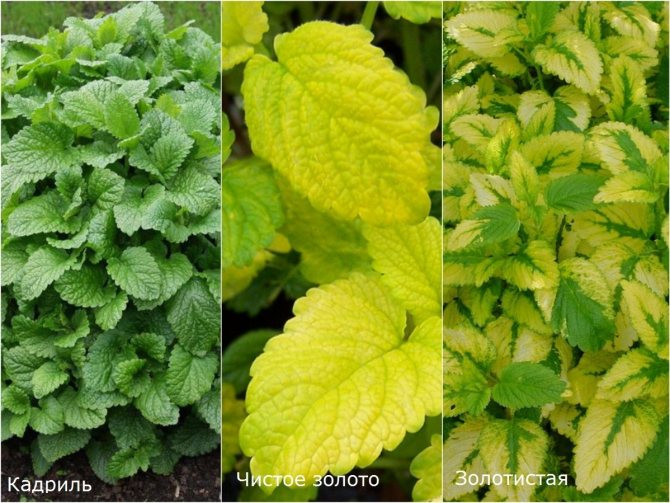

Photo: collage <>
How to choose a place and prepare the soil for growing lemon balm
In order for lemon balm to grow well, you need to create certain conditions for it.
Lighting for active growth
It is recommended to plant lemon balm in a place with good sunlight, which is especially important for the germination of naturally small seeds. Frosts can kill new lemon mint bushes, so their cultivation should begin with planting in a warm season. In the future, the plant demonstrates a fair resistance to cold weather, although the place where lemon balm grows is still better to choose on the southern side, protected from air currents coming from the north.
Preparing the soil for planting lemon balm
The soil for planting must be fertile and free of weeds. Melissa prefers loamy soils, as they have high water and air permeability, which makes it possible to grow a full-fledged plant. Loose sandstones are also possible. They need good drainage from fine rubble or broken brick, which will protect the root system from decay.
If the entire plot is located on clay soil, then at the place of planting lemon balm it must be mixed with river sand. The reaction of the soil to acidity should be slightly acidic or neutral. The first digging with weeding and fertilization can be done in the fall, and in the spring, loosen and clean the heated soil again.
Agrotechnics
Undemanding care allows you to grow lemon balm in open field conditions.
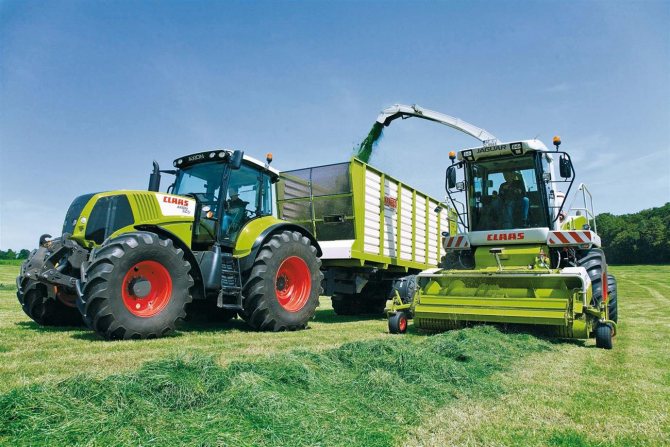

Agrotechnics
Within the garden, lemon balm must be planted in loose, well-drained, sandy loam soil or in loamy soil enriched with humus and providing the plant with sufficient water and air permeability. The main condition for how lemon balm can be grown so that it gives a rich harvest is to provide an average pH index, which should be, on average, 5.5.
The following materials can be used to make the correct drainage:
- broken brick;
- crushed stone.
The soil moisture indicator should be above average. Lemon balm should be grown in a well-lit open area.
Important! Despite its resistance to cold weather, this garden culture should be planted on the south side of the residential building - this will help to avoid exposure to strong winds.
Reproduction methods
Lemon balm is propagated:
- layering;
- cuttings;
- dividing the bush;
- seeds.
If there is an adult bush, it will not be difficult to dilute lemon balm. Several shoots are bent to the ground, securing with brackets, and sprinkled with soil mixture. After a few weeks, they will take root and be ready for transplant. To get a new plant from a cutting, you need to cut off the upper part of the shoot and put it in water. After a week, the roots will appear, the stalk can be transplanted to a permanent place.
By the end of May, shoots begin to grow, at this time the bush is divided. You can perform the procedure at the end of August. The plant is dug up, cut into pieces with roots, each should have 5-6 shoots. The separated parts take root well. With this method, the age of the bush should not be more than 3-4 years. Using the above methods, as well as seed propagation, you can grow fragrant and healthy lemongrass.
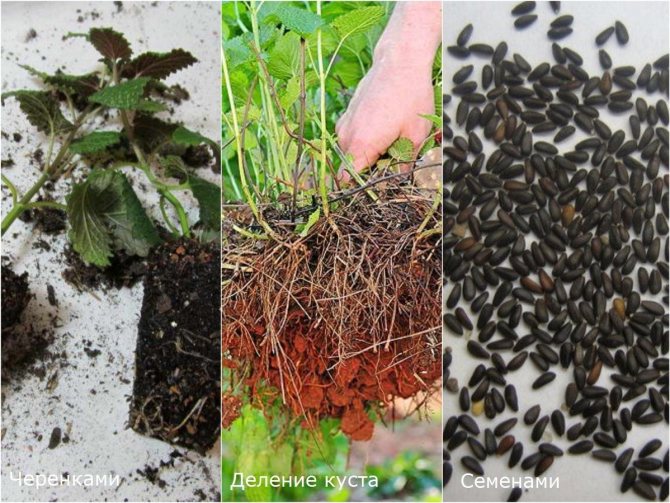

Photo: collage <>
Care
To avoid difficulties in growing lemon balm, it is necessary to properly organize the care from the first year:
- loosening the soil;
- watering;
- weeding;
- top dressing;
- pruning.
First of all, it is necessary to regularly loosen the soil and weed weeds. Up to 3 times per season, the plant is cut 10 cm from the ground. Bushes quickly recover, become more luxuriant, forming new branches.
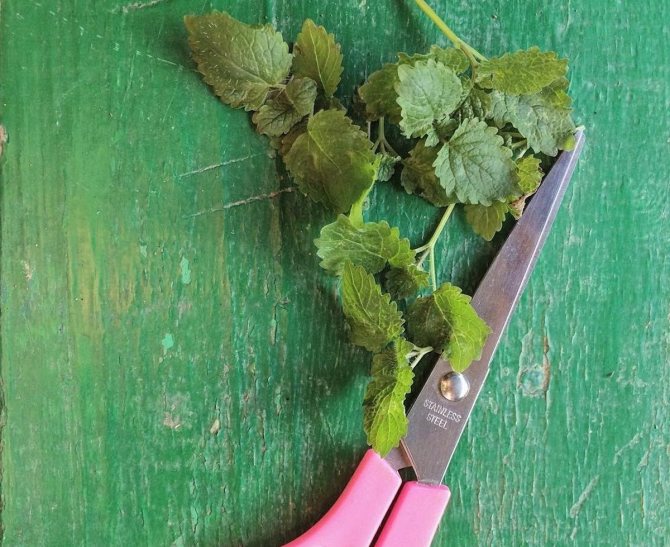

Photo:
For the winter, it is recommended to cut lemon balm, leaving no more than 2 cm. The earth is loosened, slightly moistened and covered with fallen leaves.
Every three years, the bushes must be divided, otherwise the leaves become small.
Proper watering
In hot weather, plants are watered 3-4 times a week, on cloudy days it is enough 2. To prevent root decay, after the procedure, the soil must be loosened. They do the same after the rain.
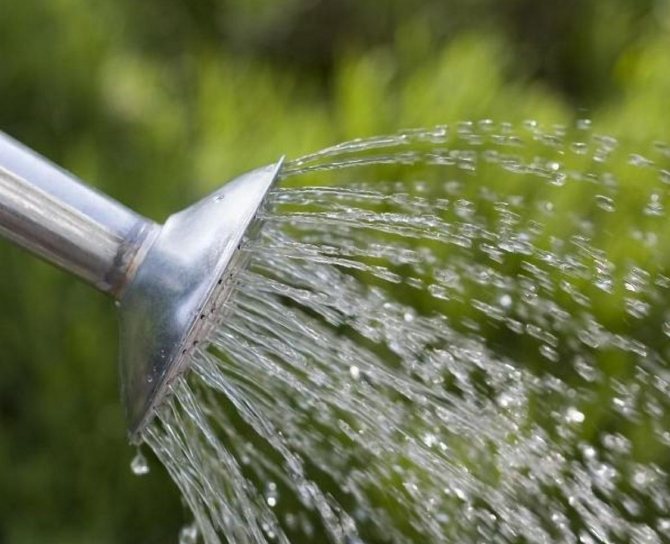

Photo:
Nutritional requirements
After planting and when the seedlings in the open field reach 5–6 cm, they are fed with nitrogen compounds for the growth and strengthening of the stem. If the leaves are trimmed during the season, after each procedure it is necessary to apply a complex mineral fertilizer, following the instructions for use.
It is recommended to mulch the garden bed with humus or compost several times.
Top dressing is not done before the flowering of lemon balm, since this leads to untimely ripening of the seeds.
Disease and pest control methods
Melissa suffers from diseases such as:
- rust;
- septoria.
To combat them, the affected parts of the plant are cut off, sprayed with Bordeaux liquid and treated with fungicides. Re-infection with septoria can occur due to the fact that the pathogen remains in the soil. Diseased plants are removed and burned. The area is then treated with fungicides several times.
The green beetle - mint leaf beetle - is the most dangerous pest. He eats foliage. To get rid of it, you should remove the growing wild varieties of lemon mint. And the places where they grew up should be treated with insecticides.


Photo: collage <>
Harvesting and storage
It is possible to cut off fragrant lemon balm branches as soon as their height reaches 10 centimeters. At the same time, they are neatly cut off and laid out on a baking sheet in one layer. During drying, the lemon balm is turned over to avoid mold. Store the herb in cotton or linen bags to preserve the aroma and health benefits.
Melissa is used fresh for preparing refreshing cocktails, desserts and main courses.
Due to the unpretentiousness of medicinal lemon balm, it is not difficult to grow it on a windowsill or on a loggia. Good lighting and timely watering are the key to rapid growth and a set of lush green mass. The first harvest is obtained a couple of months after planting, which is used for cooking or medicinal purposes.
Meet the green queen of the front garden
Melissa is a herbaceous perennial that belongs to the Lamb family. In its natural environment, it is found almost throughout the territory of Eurasia, as well as in the northern part of the American continent. It grows:
- among the bushes;
- along the banks of rivers;
- on forest edges;
- on rocky slopes;
- along the steppe roads.
Its homeland is the Mediterranean, where it is considered an unsightly weed. Despite this, in ancient Rome, experienced gardeners everywhere were engaged in the cultivation of lemon balm on their personal plots. This is what contributed to its spread throughout the continent. The name of the perennial is associated with many legends. In accordance with the most popular version, melissa is the name of the girl who was turned into an insect by the evil Greek gods. And translated into Russian, the name means "honey bee". Whichever version is correct, this does not prevent fans of green spaces from growing lemon balm in their summer cottage.
Looking at the plant from the side, one can note its excellent features:
- branched root system;
- many lush shoots with a rectangular cross section, directed in different directions;
- plant height reaches over 1 meter;
- intoxicating citrus scent.
If you look closely at the leaf plates, unusual fleshy specimens are revealed. They are strewn with many thin veins located against the background of a relief surface. The edges of the ovate opposite leaves are decorated with serrations.The tips are slightly elongated, which gives them an unprecedented beauty. All of them are colored bright green and covered with barely noticeable villi.
In the second year after planting, in the middle of summer, buds of an umbrella character appear on the tips of slender stems. Being in the leaf axils, snow-white or blue inflorescences look original against the background of a lush bush. Due to the elongated lower petals, the buds have an asymmetric shape, in the center of which there is a pistil surrounded by 4 stamens. About 30 days after pollination, fruits appear in the form of egg-shaped nuts. They are covered with a dense, shiny black crust. Inside the fruit there are 4 seeds that remain viable for about 3 years.
When buying seed, you should take into account the fact that 60 g contains more than 1500 seeds.
Lemon balm use
Melissa has long been used in cooking and medicine. The leaves of this plant are wonderful, very aromatic and healthy.
Fresh lemon balm leaves are used in all salads during the garden season. Dried leaves can be added to pickles, and powdered lemon balm leaves can be sprinkled with meat and fish dishes. We definitely use lemon balm in the preparation and decoration of stuffed pike.
We use this plant not only as having a pleasant lemon scent. Melissa is a good honey plant. Lemon balm leaves have a calming effect on bees. Therefore, during the swarming of the bee colony, we suspend fresh lemon balm shoots in advance on the branches of nearby trees. So we do not lose a young bee colony - the scent of lemon balm attracts bees.
Melissa in our family is also used in the manufacture of bath brooms. We knit branches of different trees (linden, oak,), young branches of lemon balm and nettle, and then there is a pleasant aroma in the bath.
I wish the gardeners good health, vigor of mind and body for successful work in the garden!
Tatiana Alekseevna Semyonova (Republic of Mari El, Kozhlaer village)
On site site on site site
Weekly Free Site Digest Site
Every week, for 10 years, for our 100,000 subscribers, an excellent selection of relevant materials about flowers and garden, as well as other useful information.
Subscribe and receive!
Mint is propagated vegetatively. In the first half of autumn, cuttings are cut or a mint bush with roots and a lump of earth is dug up. This lump must be cut with a knife so that 2-3 shoots with roots or buds remain in each lobe. Divided parts or cuttings should be planted in pots with a diameter of about 10 cm.
Drainage is laid at the bottom of the container, and then a moistened mixture is poured from part of the garden land or two parts of humus. The roots of the plants should be in the ground, and the aboveground part should be pruned at a height of 5 cm above the surface.
To speed up the regrowth of the leaves, the planted mint is placed as close to the light as possible.
Plants must be watered regularly with settled water at room temperature. It is desirable that it is constantly in the pan, since mint prefers air with a humidity of about 80%. It is also helpful to spray the leaves periodically.
When the mint takes root and the leaves begin to grow, you can carry out one top dressing with a urea solution (for 1 liter of water, 1-2 g of urea). As a rule, the plant is fed at the end of September. In winter, feeding is not carried out, they are resumed in February, when the sun appears.
How to care for lemon balm
The statement that lemon balm has the ability to grow like a weed plant, and that this plant does not need to be looked after, is erroneous.
However, the healthy development of lemon balm planting is possible if a number of conditions are met:
- Watering should be done every two days in hot weather and twice a week in cloudy weather. With the formation of stagnant fluid in the area of the root system, decay processes begin;
- At the beginning of each spring season, upon transition to the growing stage, under each planting it is necessary to add a bucket of solution, which includes mullein and nitrogen-containing fertilizers. Mulching with humus or old peat will help maintain the required moisture level and mineral composition of the soil;
- High hilling at the end of the autumn season will prevent the melissa bush from freezing in winter. Before this, the aerial part should be cut off and covered with a layer of fallen leaves.
Note! Every 4 years after cultivation of lemon balm from seed or seedlings, the bushes must be divided in order to rejuvenate. Refusal of such a procedure as picking will lead to coarsening and a decrease in the size of the foliage, as well as to a decrease in yield.
Landing
It is easy to get planting material, the plant propagates by seeds, layering, cuttings and dividing the bush itself.
The most laborious cultivation process is sowing seeds, but the resulting lemon balm bushes will grow longer and do not need to be changed often.
This is done in this way: seeds, pickled for several hours, are most easily planted in a manganese solution in a wide container or in small pots, but after germination they must be dived. For growing lemon balm, you can also use special peat cups or simple plastic disposable. Good drainage is preliminarily placed in the pots, and they are filled with soil. Drainage, when planting seeds, is simply a must. Usually a layer of expanded clay is used, 2-3 cm high and pours out to the very bottom of the pot. Then holes are made to a depth of 0.5 to 1 cm, the seed is planted, well watered, and the entire surface is covered with cellophane, as if wanting a steam room for the seeds. Place the pot in a warm place and in 10 or 15 days you will get the first shoots. After receiving a full two or four leaves on the stem, proceed to picking the plant into the container in which they will remain to grow further. For picking, pots or containers are used, the volume of which is 1-2 liters. The height of the pot must be 15 cm.If the pot is peat, then it can be lowered into a large pot without removing the small plant from it, and covered with soil to a height of the pot 10-15 cm.After sowing, a maximum of 7 weeks pass, and you can shoot young , juicy leaves ready to eat. In one pot with a volume of up to 2 liters, you can plant up to 5 plants at the same time.
You can plant lemon balm by dividing the bush. In the spring you dig your bush growing in your country house, garden or buy. After shaking off the soil, you will see that it can be neatly divided into several small bushes containing at least one shoot with a bud. They usually flake off on their own, you just cut the thick roots with a few buds to be sure. The separated part of the root with the buds is planted in a pot, pre-selected, a little larger than the size of the bush, put drainage on the bottom, a little soil, position the bush so that the buds are as high as possible, and fill it with prepared loose soil, watering and heat will do their job and sprouts will appear on your windowsill.
When is the best time to sow?
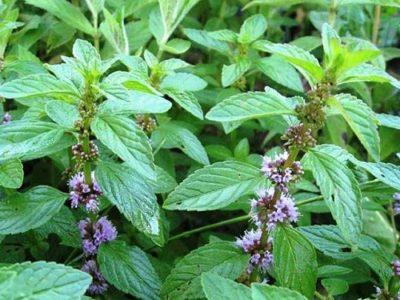

Of the known types of lemon balm, the most popular is Melissa officinalis. In total, 8 varieties are included in the State Register of the Russian Federation, but it is the medicinal one that takes root better than the rest in our climate. Saplings at the time of planting must be at least two months old - these take root faster. Since frosts mercilessly destroy immature sprouts, they should be planted at the end of April, when the danger has passed.
All known varieties branch profusely, expanding and spreading roots in breadth, so the allocated space should be spacious enough. 6-7 bushes are enough for both use and storage.
How to fertilize the soil?
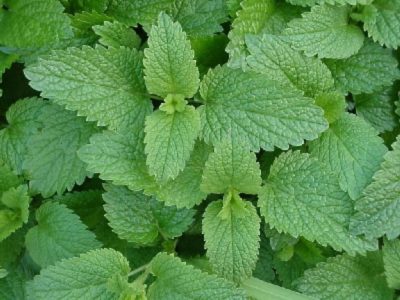

Lemon balm is fed once a month.Apply wood ash, manure, humus, or add complex fertilizer.
Every spring, mineral fertilizers containing phosphorus, potassium, nitrogen are required, and for the winter it is advisable to cover lemon balm by spilling the bush with humus or peat and falling asleep on top with fallen leaves.
Fertilizers strengthen the root system, increase resistance to adverse weather conditions, and promote plant growth. When there is a lack of fertilizer, the taste of the leaves deteriorates - they become bitter, less juicy and aromatic.
Pests - diagnosis and control
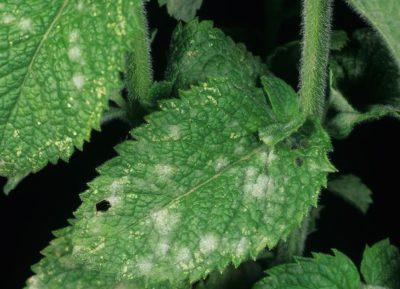

Melissa attracts not only people but also pests. Most often these are spider and spotted mites, whiteflies, and aphids. After the appearance of these unpleasant insects, lemon balm stops growing and withers. Ticks entangle the plant with a thin cobweb, the whitefly leaves behind a sugary discharge, on the basis of which a sooty fungus develops, the aphid settles on the seamy side of the leaves in colonies and drinks all the juices from the plant.
You can try to clean the house plant with a hot shower, followed by a bath in soapy water or garlic broth., and a garden plant - by spraying with special insecticides ("Aktara", "Iskra", "Tanrek"). Biological products are also recommended - "Fitoverm", "Trichopol", "Aktofit", "Fufanon", "Jaguar".
Lemon balm contraindications
Melissa is a useful plant and has almost no contraindications. And yet, some points related to its use are worth paying attention to:
- Do not abuse the use of infusion, broth, lemon balm tea for men. This can lead to an undesirable decrease in sexual activity.
- It is not recommended to drink drinks containing this herb before a responsible event, meeting, exam. Excessive calmness and insufficient response can adversely affect the outcome of the event.
- Treatment with lemon balm should be abandoned in case of individual intolerance or persistent hypotension.
In all other cases, lemon balm will benefit your body, prolonging and improving the quality of life.
Melissa on the windowsill. Video
Procurement time
Leaves of fragrant greenery are harvested no later than at the end of August, so that the plant can still grow before winter. The grass is cut, leaving 5-10 cm above the ground. The leaves are used both fresh and dried.
Melissa is incredibly easy to grow in Mediterranean-style flower gardens, in containers, in
On the garden plot, you want to grow unpretentious, multifunctional plants. Planting lemon balm (popularly - lemon mint) will allow you not only to evaluate its benefits for the body, but to get a decorative element for the flower bed and for the home.
Mint and lemon balm: cultivation, healing properties
The most popular medicinal herbs that are grown on the site are mint and lemon balm. Tea made with these plants is always popular. And how to properly grow them and use them, in addition to tea, will be discussed in the article. In addition, we will figure out what medicinal properties they have and how to use them in group plantings.
Features of growing mint
This unpretentious plant has several types, but peppermint is valued for its taste and medicinal properties. Gardeners grow it most of all. A delicate, sweetish taste with a rich mint aroma is just the case when taste and benefit are combined.
Mint is an unpretentious plant. It can grow both on chernozems and on sandy and clayey soils. The main thing is watering. Remember to water, especially on hot days. Then, even sunny territories can be mastered by this plant. But the advantage must be given to penumbra. But stagnation of moisture is contraindicated. Root decay can lead to the death of plantings. Mint multiplies:
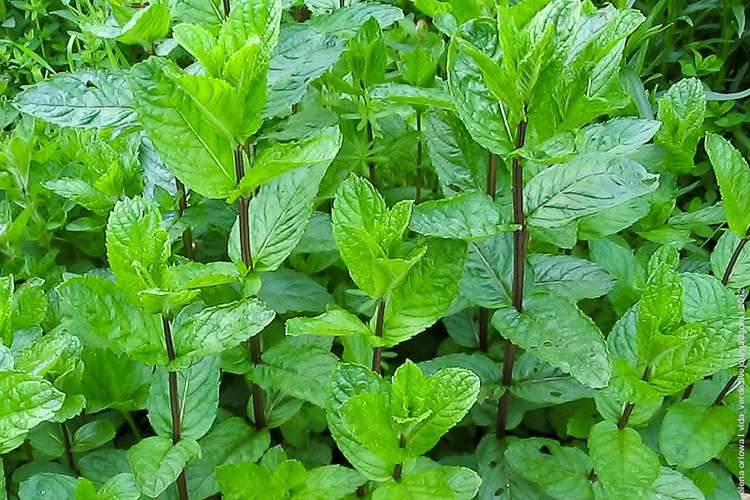

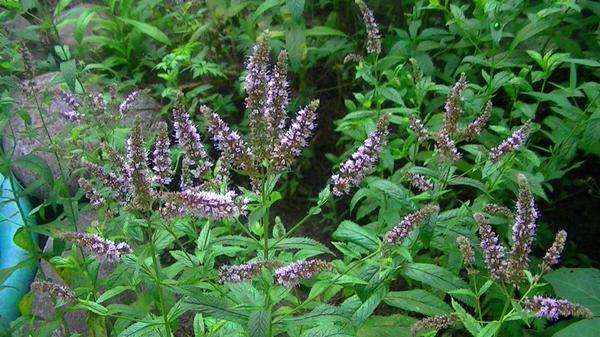

Features of growing lemon balm
Melissa has a number of popular names: lemon mint, bee mint, mead, lemon grass.And all because the delicate aroma of this plant resembles a mixture of mint with citrus zest. And the flowers are excellent honey plants, attracting with the aroma of bees. But if it is necessary to prepare a decent amount of raw materials, then it is unnecessary to allow flowering.
When it comes to growing lemon balm in a personal plot or in a garden, then you need to pay attention to the following points:
Knowing these features of growing lemon balm, you can not be afraid and boldly breed this fragrant and healthy crop on your site.
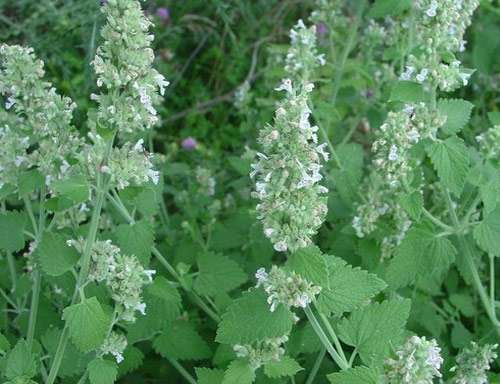

Use and medicinal properties of mint
When it comes to mint, tea and mojito cocktails come to mind. But as a seasoning - this herb is not remembered. Although, meat and vegetable dishes seasoned with powdered dry mint leaves have a very pleasant taste and delicate aroma. Fresh leaves can be added to vegetable and fruit salads.
The main thing is to remember that at home, without a doctor's prescription, you need to use mint teas and infusions for preventive purposes. During an exacerbation of the disease, you need to see a doctor.


Application and medicinal properties of lemon balm
Lemon balm is used in cooking as a seasoning for summer salads, mushroom and pea soups, meat dishes. Essential oils are used in aromatherapy and perfumery.
Read also: Argirantemum: planting and care tips for lush bloom
Melissa, like mint, has a calming, antispasmodic effect. Therefore, teas and infusions of this plant are taken when:
- headache;
- nervous excitement;
- nausea;
- insomnia;
- low appetite;
- allergic dermatitis;
- poor digestion.
For insomnia and headaches, you can make tea from mint and lemon balm. Also, this tea is suitable for difficult digestion.
Remember! Large amounts of herbs during exacerbation of diseases are contraindicated.
Mint and lemon balm in group plantings
If the purpose of growing is not only the medicinal properties of these plants, but also decorativeness, then you need to take into account:
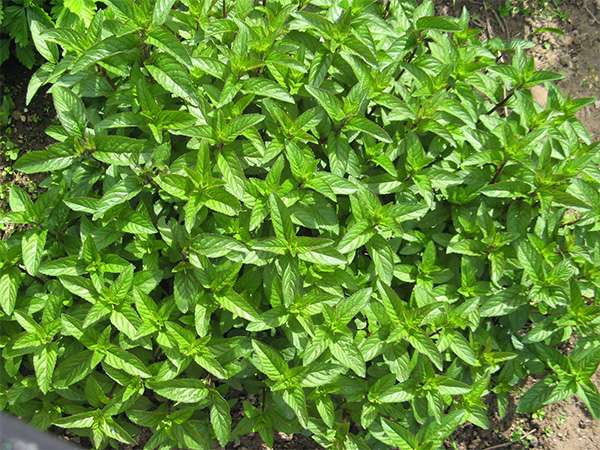

For its aroma and calming, pacifying effect, lemon balm and mint, by right, are leaders among other medicinal herbs in summer cottages. Having mastered the simple principles of growing these plants, you can delight yourself and your loved ones with pleasant and healthy teas, aromatic dishes, and your flower beds - with original compositions.
How to grow at home correctly?
Melissa does very well indoors... An eastern, western or southern window sill is chosen for the pot. However, direct sunlight can burn delicate leaves, so for shading you need to purchase a screen or hang thin curtains on the window.
In the winter months, the lack of light should be replenished with a fluorescent lamp with a power of 40 to 80 watts. It is enough to hang the device over the plant (60 cm) and turn it on at 6-7 hours in the morning.
It is useful for containers with greenery from time to time to arrange air baths, taking them out to an open balcony or into a garden. Homemade lemon balm does not grow more than half a meter.
When melissa blooms
Melissa begins to bloom in its second year of growth. The flowering period of lemon balm falls in July-August. Before flowering, the plant smells of lemon scent, at the end of flowering, the aroma becomes sharp.
When to plant
Lemon balm propagation by dividing the bush
You can divide the bushes 3-4 years old - by this time they will grow well. The most favorable terms for division are the end of May or the end of August. Dig out the bush carefully and divide it into approximately equal-sized pieces, each of which should contain formed roots and 4-5 shoots. Plant the strips directly into the open ground. For them to take root well, provide straining and moderate watering.
Propagation by cuttings
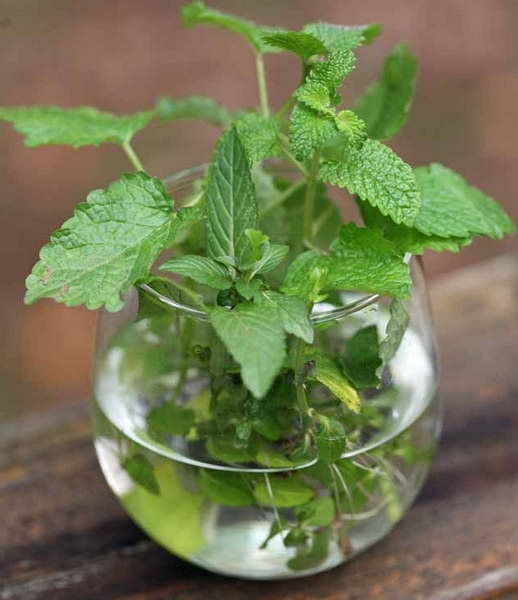

For spring rooting, cut from young shoots. After cutting, place in water, you can add a growth stimulant. The roots will appear in about 2 weeks.Grow in a container with nutritious loose soil, then transplant to open ground.
Melissa propagates easily by cuttings, and if you don't want to disturb old bushes, just cut the cuttings and root to quickly get excellent planting material.
How to harvest and store crops
Melissa bush, including home, blooms by mid-June. Flowers blooming in the axils of the leafy part can be painted in one of the colors typical for this plant:
- white;
- lilac;
- pink.
Advice. It is recommended to plant a medicinal lemon balm bush near fruit trees.
The cut of the leaves is carried out before the flowering of the shrub or during the transition to this stage. One bush planting of lemon balm is capable of producing a harvest of fresh fragrant greens for 3 harvests in one season. For drying, lemon balm leaves are laid out in the shade in a thin layer. The storage of this medicinal herb is recommended in a well-closed container made of glass or tin material. This amount of harvested grass will last until the end of winter.
This fragrant medicinal plant is able to grow in any home garden. If you know how to plant lemon balm correctly (for example, you can plant lemon balm in a pot at home on a windowsill, in a country house from seeds or in the form of ready-made seedlings), observe each condition of agricultural technology, how to grow lemon balm, an important feature of which is maintaining acidity at the required level, you can regularly harvest a good harvest of this wonderful crop, which at the same time is able to decorate the garden.
Sowing technology
The first priority before sowing is soil preparation. You need to take 1 glass of vermicompost and 2 glasses of coconut fiber. Mix the ingredients thoroughly and add to this volume the recommended dose of the mineral fertilizer complex.
Sowing in containers or boxes is carried out in the second half of March.
- Several grooves need to be made in the soil, the distance between which is 4 - 6 cm.
- The seeds are small and should be mixed with a little sand to facilitate the sowing process.
- Distribute the mass along the grooves to a depth of 0.5 - 0.7 cm.
- Moisten the soil surface.
- Cover the container with glass or plastic.
- Put in a sunny, warm place.
After the emergence of seedlings, the box must be placed so that they receive a sufficient amount of light, but do not fall under the scorching rays. Watering should be carried out as the soil dries.
Seedlings appear 2–25 days after planting. After the appearance of several leaves, it is necessary to make a pick. This is done so that the seedlings do not stifle each other's growth and development. The distance between the stems should be at least 5 cm. If the sowing was carried out in a special container, then in one cell, where several seeds need to be planted at once, the weakest sprouts are removed.
Transplanting into open ground is carried out in the second half of May. To do this, you need to prepare a seat.
Melissa can grow both in a well-lit garden bed and in partial shade. When given enough light, the bush will exude an intense scent.
It should be borne in mind that this culture is perennial and grows from 4 to 9 years.
The soil should be loose, light and nutritious. Mellisa does not like acidic and moist soil. Excess water contributes to decay of the roots, so the place for the bush should be chosen dry, where moisture does not accumulate during precipitation. If the ground is heavy in the chosen place, then you need to add several buckets of fine sand.
After choosing a place, the soil must be fertilized. To do this, 1 sq. m. of soil is introduced:
- 200 g of wood ash (1 cup);
- 10 liter bucket of humus;
- Complex mineral fertilizer, the dosage is indicated on the package.
It should be planted in small trenches located at a distance of half a meter from each other. Each plant needs to be planted in a hole with an interval of 30–35 cm.
If you decide not to grow seedlings, but to plant seeds immediately in open ground, then you need to be prepared for poor germination, even careful care may not help. This can be influenced by several factors:
- low quality of planting material;
- heavy rainfall;
- "Clogging" of sprouts with weeds.
Landing is carried out in the 3rd week of May according to the following algorithm.
- Make holes at a distance of 50 - 60 cm from each other.
- Mix the grains with the sand.
- Deepen the mixture by half a centimeter.
- Sprinkle with peat or humus.
- Moisten the soil surface.
- Cover with foil.
To harden the seedlings and make them more hardy, you need to remove the film. First, for several hours, then for a whole daylight hours, and after the pick, the covering material is finally removed.
Lemon balm is propagated both by seeds and by layering and cuttings. If you already have an adult lemon bush, then planting it will be much easier: bend a few shoots to the ground, fix them and sprinkle them with earth. After a few weeks, the branches will take root and can be transplanted to a new location.
And in order to propagate by cuttings, it is enough to cut off in the garden from friends or buy a bunch of fresh herbs in the store, shorten the stems by 2 - 3 cm and put them in water. They do not require additional care, a root system appears in a week - and the cuttings are ready for planting in a flower bed.

